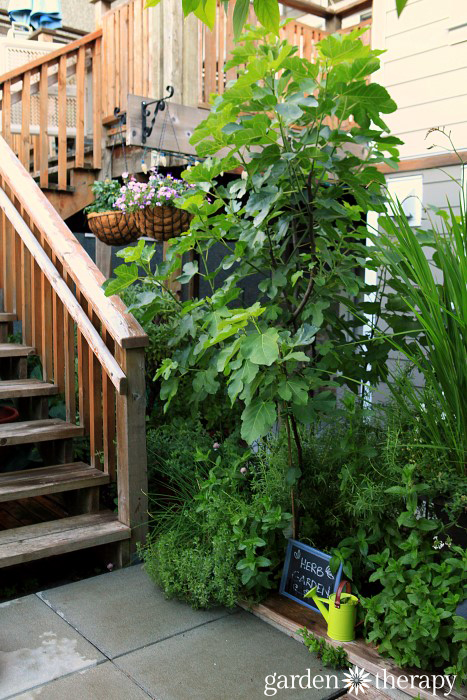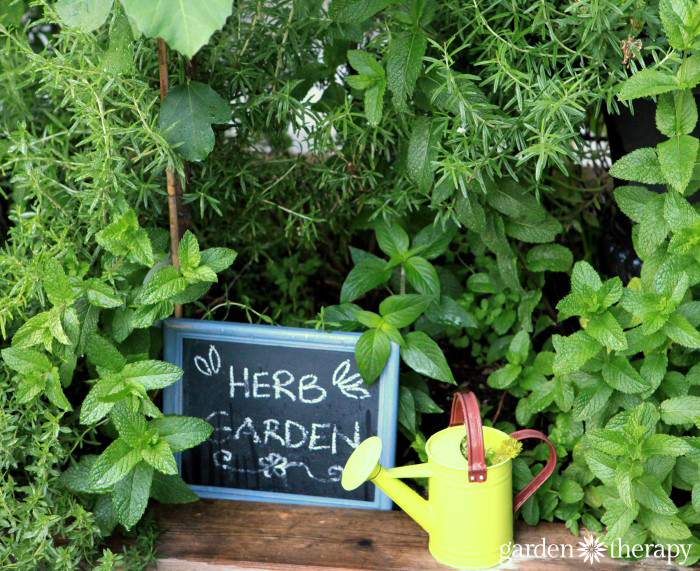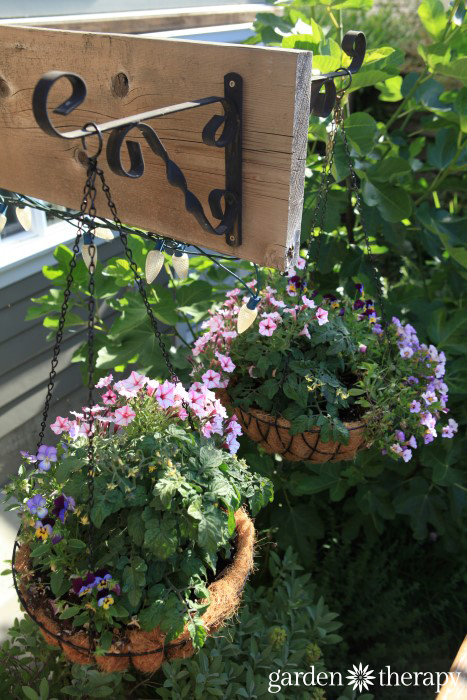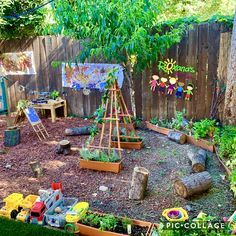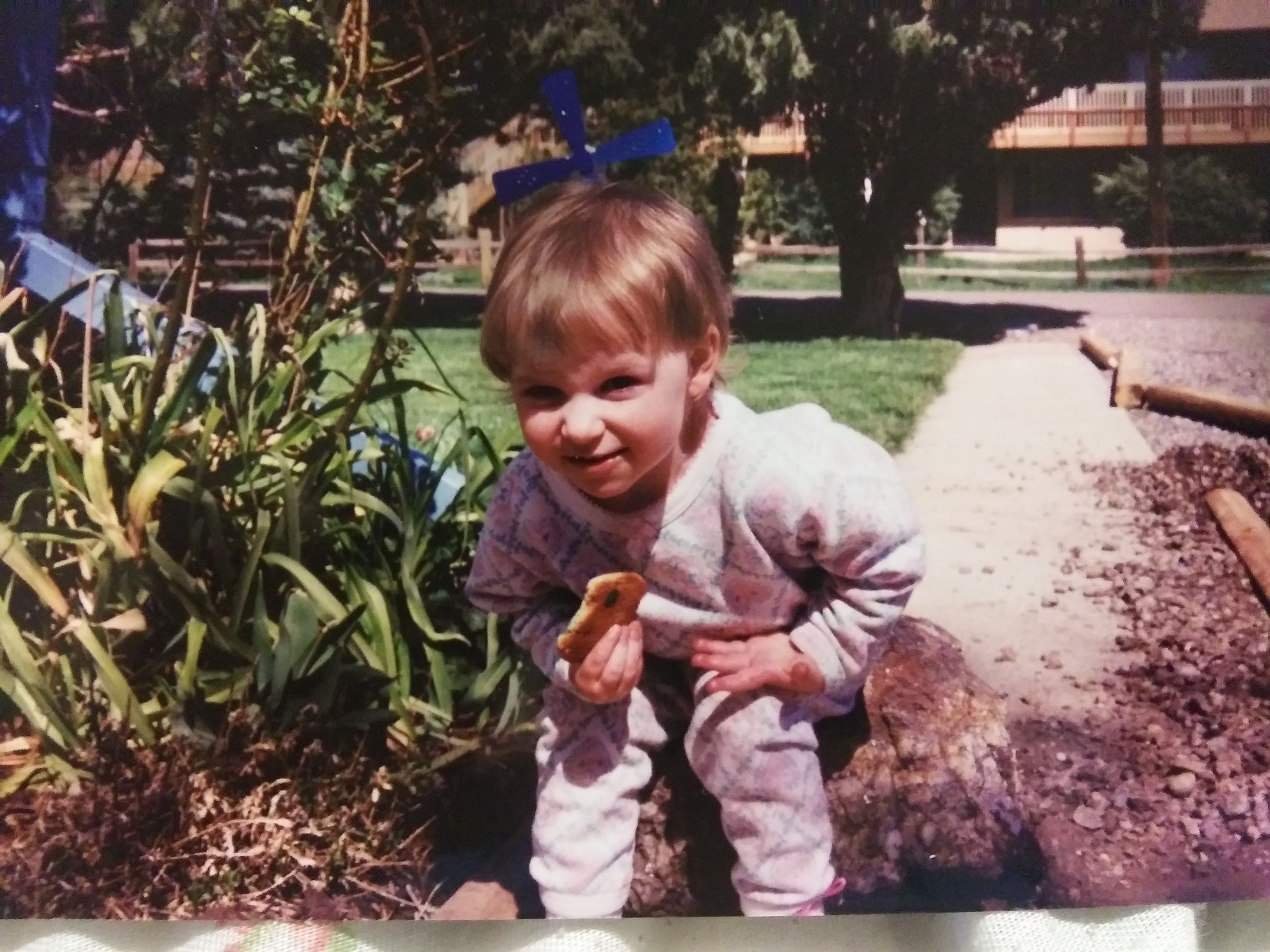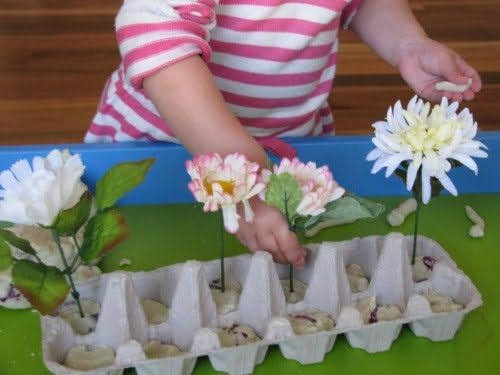
13218307041
Outdoor Family Activities- Play Garden - Backyard Family fun IncredibleKids.com
Tips For a Happy,
Healthy Family

15NOV
At
mutual support
love and caring for each other
a sense of security and belonging
open communication
a confidence within each family member that they are important, respected and valued
This page also includes
Finding a Balance between Green time and Screen time (Section 2)
Common Traits of Successful Families (Section 2)
How to get your child to play outside (Section 2)
Create Your Own Natural Playground in Your Yard (Section 2)
Play Gardens for Unstructured Play (Section 3)
6 guidelines for maintaining a healthy, well-functioning family
Dinner: 30 Minutes to a More Connected Family
Believe it or not, time spent having dinner together as a family is an excellent gauge of how well kids will navigate adolescence. The more frequently kids eat dinner with their families, the better they do in school and the less likely they are to get involved with drugs or alcohol, suffer depression, consider suicide or become sexually active during high school. Why? Maybe because families who eat together talk more, which helps them stay connected and build better relationships. Dinner transforms individual family members into a “group” – all for one and one for all. And, children, even more than adults, need something to count on every day, the tangible security of belonging and being nurtured that is represented by the ritual of sharing food with those who love you.
Why Kids Need Routines and Structure
Children are confronted with change daily, which can be stressful. Their own bodies change on them constantly. Babies and toddlers give up pacifiers, bottles and cribs. School-age kids have to get used to new teachers and classmates every year. They learn new skills and information at an astonishing pace, from reading and crossing the street to soccer and riding a bike. Few live in the same house for their entire childhood; most move several times, often to new cities, new neighborhoods and schools. Routines give kids a sense of security and help them develop self-discipline. And few of these changes are within the child’s control. That’s why dependable, productive routines can keep stress and tempers at bay and give soothing structure to family life.
The Family That Plays Together
From a joke-telling competition to an impromptu pillow fight, infusing a spirit of joy and playfulness into your home nurtures your family like little else. Playing together is an almost magical way to build connection, because when you’re laughing with someone, you’re bonding. Laughter also heals minor relationship stress, helps people forget grudges, and brings the family into cohesion. We have seen that children whose parents use silliness to keep the day flowing smoothly are lucky indeed.
Family Meetings
If the idea of family meetings seem stilted and artificial, our advice is: just try them. They create connection. They give you a way to work things out when everyone’s calm. They help your kids learn to solve problems. They help kids feel like integral members of the family. They give every family member a voice. They even help siblings work things out and appreciate each other. Again, schedule a couple and let us know how they worked.
Make Your Home a Haven
To thrive, we all need a safe place — both physically and emotionally — to come home to. Children especially need a secure, solid home where they feel protected and can recharge. No matter how independent they become after they start having sleepovers and sports tournaments, when they come home they want two things: a safe place where they can be fully themselves, and to connect with the rest of the family in a comfortable way. So what can you do, in this busy world, to create a sanctuary for your family?
Family Culture:
Shared Identity and Belonging
How do you hold a family together? How do you make kids WANT to spend time with the family? The answers to these questions largely have do with the family culture you create. For example, take an interest in each other’s interests and hobbies, like Star Wars, ice skating or cooking. Seize any excuse to celebrate and have fun together whenever possible. As stated earlier, share dinner together whenever possible. And most all, create family rituals. Through their repetition, rituals reinforce family cohesion through shared, cherished experiences (Jack-O-Lantern carving, birthday celebrations, July 4th picnics).
Maintaining a healthy family
In order to provide a supportive, emotionally-healthy environment, you might consider the following questions:
Do you treat each child as an individual? Each child has his/her own temperament, strengths and weaknesses. Parents may love their children equally, but naturally will have different relationships with each of them. It’s important to develop a unique relationship with each of your children, reinforcing their talents and “specialness.”
Are your expectations of your children realistic? Your child’s maturity, self-awareness, knowledge and skills are constantly changing. Find out what can reasonably be expected of him/her at each stage of development. At Westchester Health Pediatrics, we can help in this area; please come in and talk with us.
Does the time you spend together as a family foster good relationships? Can you describe your “family togetherness” time as fun, relaxed and mutually beneficial…or tense, competitive and full of conflict?
Are you teaching your child solid, positive values? Remember, you and your spouse are the most important role models for your child and you need to demonstrate your value system, through actions as well as words.
How can I encourage my kids
explore and play outdoors TODAY?
Remember, this is a muscle or skill to enjoy nature or outside play that needs to be built. It may take some time but you can do it! All kids know how to play, we just have to create opportunities for it!
Tip 1: Start playing with them. Initiate play, get them engaged, and then step away for a few minutes. Come back and check in and notice what they're doing. Independent play is a foundational skill and the more you foster it, the more your kiddo will do it.
Tip 2: Create invitations to play. An invitation to play is taking 3-5 minutes to arrange some intentional materials that kids can use in a very open-ended way to create play around. Your kiddo may or may not “accept” the invitation, which is absolutely OK! It could be a small art project, animals set up, building toys out, some things out of the junk drawer, really, ANYTHING!
Tip 3: Tweens and teens … yes, they need to play! Play for tweens and teens comes down to their specific interests.
Begin by having a conversation about something they may be wanting to explore, but may not have time or the opportunity: something to engage their minds. This could come in the form of an art technique, building something, STEAM activities, cooking, songwriting, or a new puzzle.

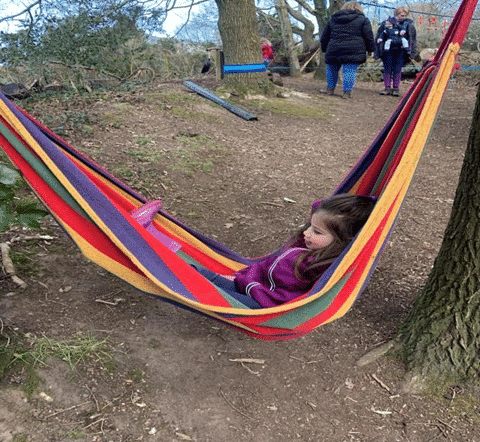

The thought of a parent or adult being outside and enjoying themselves along side of them will help motivate them to go outside with you. It will also give you all the great benefits of being in fresh air and sunshine as well.
Sit down a spell because outside play should be 75% free time or freeplay. Bring out their favorite playthings or set up new and interesting activities to explore and discover outside. Create an personal plan to rekindle or discover outdoor hobbies of your own as you treat yourself tech-free time too.
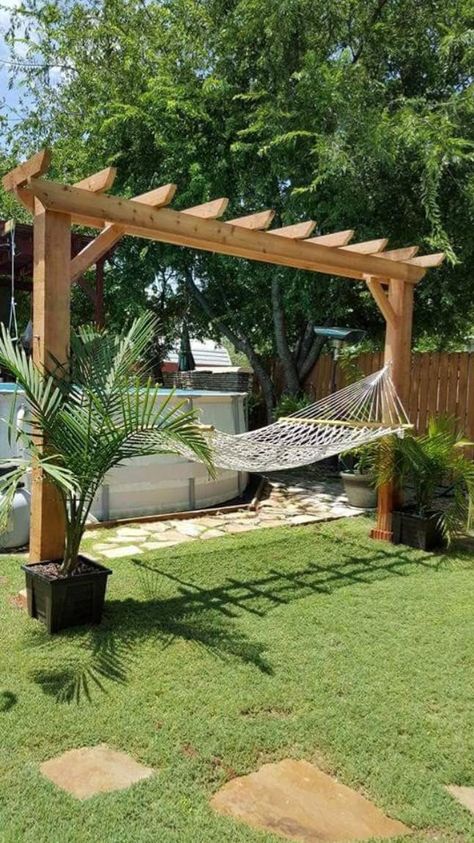

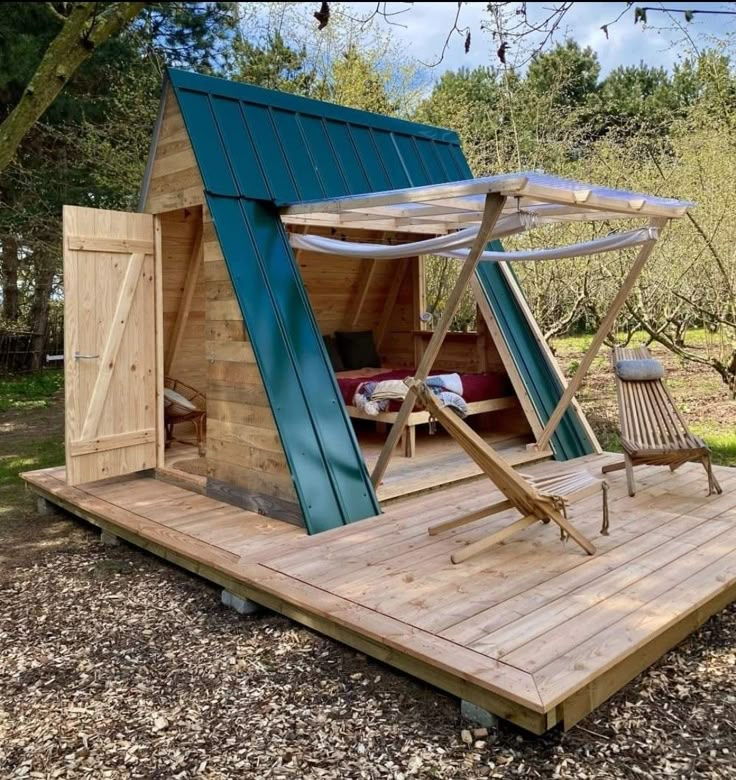
Your children will love the freedom to be as loud and rambunctious as they want too. They will learn to love freeplay outside if you set out some balls, blocks and develop play stations with your child's favorite inside toys and/or craft supplies
Guide or help them to explore new interests outside.
Make exploring new things (or new types of play) fun for littles. And try outdoor challenges or quests and sports for stirring interest older kids.
Play Gardens for Unstructured Play (Section 3 below)
10 TIPS FOR WEANING CHILDREN OFF SCREENS
Written by Children and Screens
For much of the pandemic, screens have provided a lifeline for children, helping them socialize and learn, so it’s understandable that both kids and parents may have grown more attached to their digital devices and connectivity than ever before. Now that some parts of the world are beginning to open up, families may need support as they navigate the transition back to “real life.”
“Asking kids to put their screens away cold turkey, even for a highly-anticipated week of summer camp, is a tall order. It can be even harder for parents to give up the ability to reach our kids at any given moment or to hear an ongoing report of our kids’ days,” says Pamela Hurst-Della Pietra, president and founder ofChildren and Screens: Institute of Digital Media and Child Development. “Depending on the age, it is beneficial for children to have (safe) space to make their own decisions, solve their own dilemmas, and foster new relationships. Reducing screens this summer can help our children and teens transition to face-to-face interactions and real-world experiential fun and learning.”
Summer camps, which may have rules limiting screen use and/or require children to be away from home for perhaps the first time in over a year, represent both a challenge and an opportunity for young people who might not feel ready to cut back on their digital media use. With that in mind, the folks from Children and Screens have invited distinguished researchers, clinicians, educators, and parenting experts to share their tips on the best ways for children (and their parents) to deal with the sudden drop in screen time. Check out their 10 pieces of advice for weaning children off screens below!
1. PRACTICE MAKES PERFECT
Sometimes, the fear of the unknown is worse than the experience itself, so practicing what it’s like to go without screens before kids leave for summer camp—or head back to school—can help ensure a smooth transition. “Try out a screen-free afternoon and encourage fun, screen-free activities at home,” says Sarah E. Domoff, PhD, Associate Professor, Department of Psychology, Central Michigan University. “Parents and other caregivers may also find it tough to go without instant contact with their children, so do a trial run of no phone contact for a day or so.” Domoff recommends writing postcards or drafting up letters or emails to send at a later time as a way for families to still feel connected during sleepaway camps, and suggests downloading any appropriate music or podcasts kids might want to listen to in advance of extended periods without WiFi.
2. OUT-BUSY YOUR SCREENS
After a year of constant connection, it’s natural for kids to feel like they’re missing out by unplugging, but parents can help their kids find ways to work through this fear. “Encourage your kids to focus on activities they can do with others that can help take their minds off any negative thoughts,” says Elizabeth K. Englander, PhD, Executive Director, Massachusetts Aggression Reduction Center, Bridgewater State University. “Suggest that they take a walk, read a book, or play a board game. Remind your kids that when they occupy your brain with sights and sounds, it forgets to worry!”
3. BUILD BETTER BOUNDARIES
The ubiquity of screens over the past year can make the process of disconnecting seem like a particularly daunting one, but it’s essential for kids’ development. “In order for children to re-establish face-to-face social skills, they need the space to do so without the distraction of a device,” says Meghan Owenz, PhD, Assistant Teaching Professor, Rehabilitation and Human Services, Penn State Berks. That means parents need to have frank and open discussions with their kids about what will and won’t be allowed as they move forward. “With clear boundaries around device use,” says Owenz, “children know what to expect and develop other skills.”
4. TAKE A VACATION (FROM YOUR SCREENS
Sometimes you just need to get away from it all. “If your family can take a screen-free vacation for a week or more (ideally, 2-4 weeks), it will provide a period when your child’s brain can start coming back to more normal functioning and new, healthier patterns can be established,” says Hilarie Cash, PhD, LMHC, CSAT, WSGC, Chief Clinical Officer of reSTART Center for Digital Technology Sustainability. “Alternatively, if such a screen-free period is not possible, then a slow, steady cutting back on screen-time can be conducted, with alternative activities introduced and encouraged, all the while discussing with your children why this is important and engaging with them as you figure out the new limits.” Cash reminds parents that kids are always watching and learning, so it’s important that you follow the same rules when you’re together.
5. TIME TRAVEL TOGETHER
The slower summer months can provide families with important, real life bonding time that the busy school year might not allow. “Bonding in real life should be the priority for all of us—even if it’s just a trip to the store or the local library—so that when summer is over, we will have strengthened relationships and support systems as we pick up our technological tools again,” says Dr. Elizabeth Milovidov, J.D., a digital parenting expert. Milovidov recommends sharing stories with your kids about technology and entertainment in the “good ol’ days” and encouraging them to experience what life was like in different eras by playing with everything from classic board games and jump ropes to marbles and Polaroid cameras.
6. MAKE SIMPLE SUBSTITUTIONS
One of the easiest and most impactful ways to cut down on screen use is to substitute books for phones at bedtime. “This helps children cut down on overall screen time, improves their sleep, and keeps up their reading skills over the summer,” says Cori Cross, MD, FAAP. For parents who are struggling to get their kids excited about reading, Cross suggests developing fun goals as a family. “Keep track of how many nights they read before bed,” she says. “If they meet their weekly goal, the family can celebrate with a fun weekly dessert such as Friday night s’mores or mini root beer floats.”
7. EXPLORE (SCREEN) FREEDOM
Good weather is a great excuse to get the whole family outside. “Summer is a time to explore and go on new adventures, breathe fresh air, and be present without the distraction of screens,” says Cam Adair, founder of Game Quitters. Adair recommends turning screen-free time into a fun experiment. “Start by taking a break and spending more time offline. Be curious and notice what you enjoy about it. It can feel nice to disconnect and quiet the noise of social media, and this contrast can help us live a more balanced life.”
8. STAY FOCUSED
Living through screens all the time, it can be easy to miss the big picture, but it’s important for parents not to lose sight of the core ingredients that are essential for children’s growth. “We must teach our children to look within and develop the ability to express and verbalize thought, empathize with others, and express their own concerns, both positive and negative,” say Laurel and Norm Barrie of Camp Connection. They remind parents that truly caring for children means listening to what they have to say, even when it’s not what you want to hear. “And finally,” they add, “helping your children navigate all this will be your children’s reward, nurtured by you, the parent.”
9. STARE AT THE BIG SCREEN
There’s nothing like lying under the stars as a family, searching for shooting stars and learning how to identify the constellations. “We used to huddle together on our picnic table for what felt like hours with our children of all ages,” says Catherine Steiner-Adair, EdD. “Screens have deleted the time for daydreaming, for gazing at the real clouds, for solitude. Encourage your kids to read the wonderful myths from different cultures that tell stories about the constellations, and invite everyone to make up their own stories about what they see in the night sky. There’s something awe inspiring and cozy about staring at the big screen and sharing that vast space together.”
10. RIDE THE SUMMERTIME WAVE
Summertime presents an opportunity to reevaluate family media use norms that are established during the school year. “Parents can piggyback on natural and required shifts brought about by summer camp or family vacations to implement new patterns for media use,” explains David S. Bickham, PhD, of the Boston Children’s Hospital’s Digital Wellness Lab in the Division of Adolescent Young Adult Medicine. “Say things like ‘Camp starts earlier than school so we’ll need to put phones away an hour earlier each night this week,” or ‘We should leave our phones behind when we go to the beach so that they don’t get broken, lost, or stolen.’ Taking these opportunities can help reset your family’s use habits and move you all toward being more intentional users.”
Since its inception in 2013, Children and Screens: Institute of Digital Media and Child Development has become one of the nation’s leading non-profit organizations dedicated to advancing and supporting interdisciplinary scientific research, informing, and educating the public, advocating for sound public policy for child health and wellness, and enhancing human capital in the field.
Play Gardens for Unstructured Play
(Section 3 Below)
My YMCA Training Curriculum Featured on How Stuff Works:
10 Earth Day Activities to Celebrate Our Planet - HowStuffWorks
Animal Activities
SECTION TWO
Finding a Balance between Green time and Screen time
Green time is better than screen time
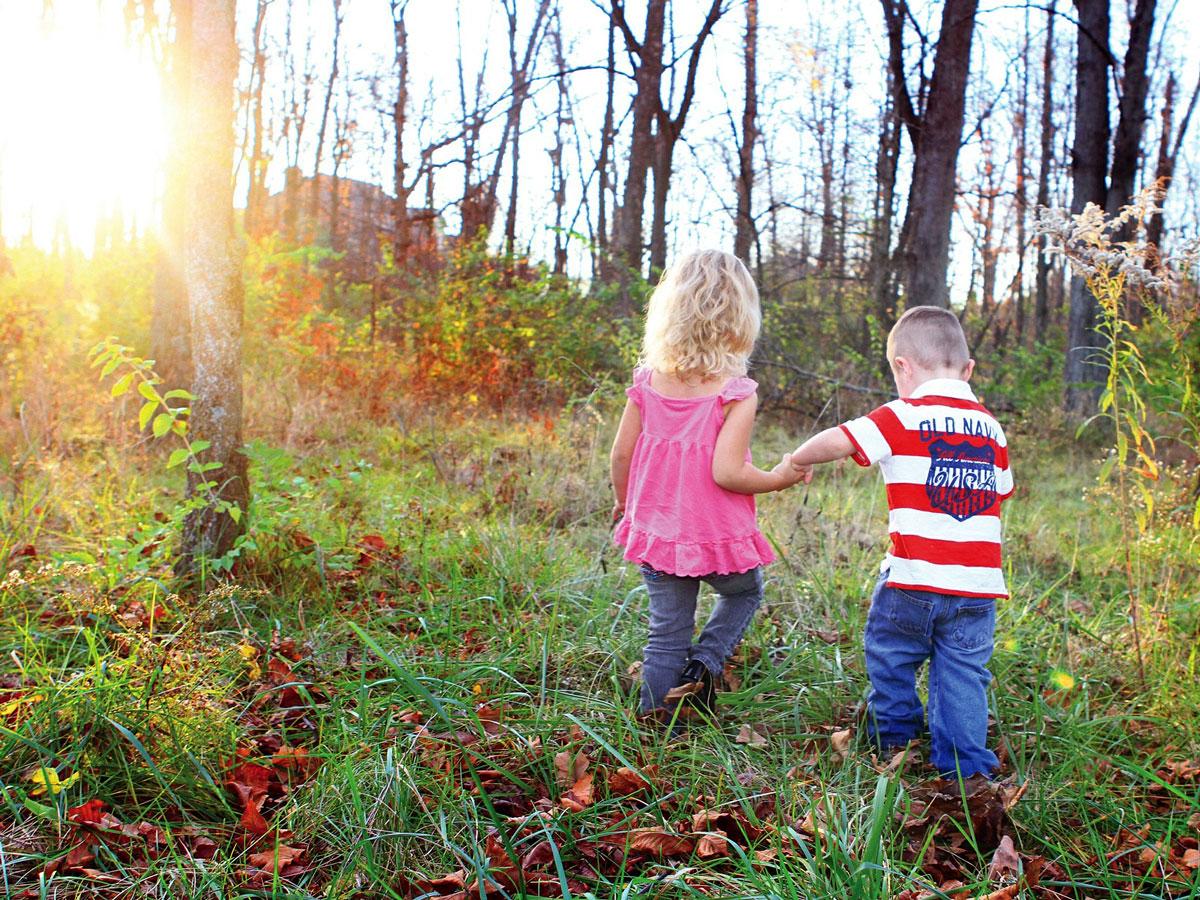
Children and teenagers could potentially improve their wellbeing and achieve better school results by spending more time outdoors, University of Adelaide research suggests.
Green Time vs. Screen Time
The Children Nature Network compiled data from 186 studies. They state, “generally, high levels of screen time were associated with unfavorable psychological outcomes, while green time tended to be associated with favorable psychological outcomes.”
Unfavorable psychological outcomes from screen time include
Depression
Anxiety
Stress
Psychological distress
Poor self-regulation
Emotional challenges
Negative affect or mood
Favorable psychological outcomes from green time include
Happiness
Resilience
Hope
Prosocial behaviors
Positive affect
Self-esteem
Cognitive functioning
Academic achievement
For these reasons and more, We emphasize outdoor learning and play as important aspects of the school day for each student in every grade. We encourage limiting media use and screen time to high school students.
Tassia suggests that further research will help us to work out whether we should focus our efforts on reducing young peoples’ screen time; or whether simply increasing ‘green time’ alongside their ‘screen time’ would be beneficial for their psychological wellbeing.
“Prevention is key and identifying exposures which harm or help mental health is especially important for young people,” she says.
“The psychological consequences of excessive screen time appears to possibly be worse for these children, while psychological benefits of green time appears to possibly be greater for these children.”
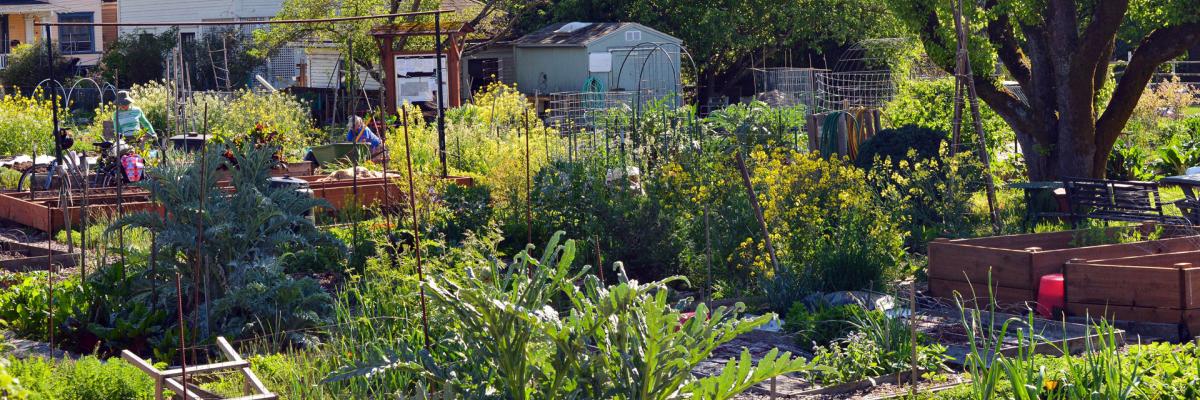
Kids' 'green' time reduces adverse effects of 'screen' time on behavior, learning
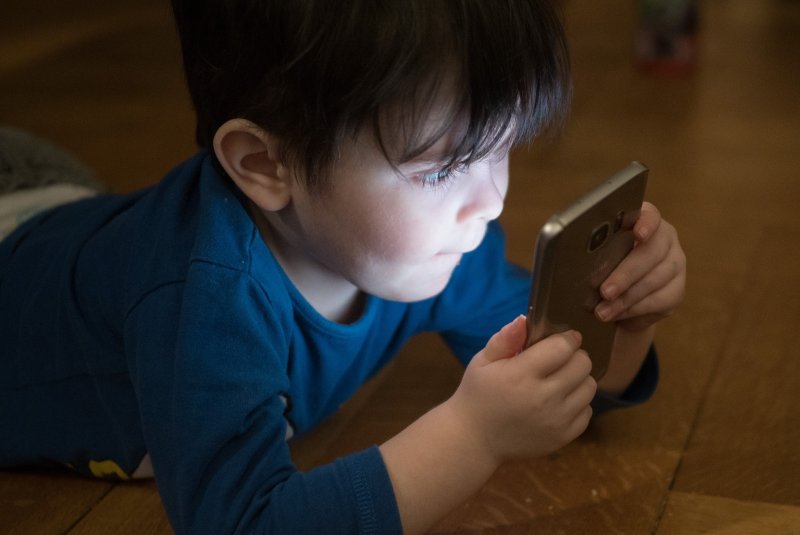
Studies show screen time can adversely affect behavior and learning in children, but the effects can be balanced with increased time outdoors. Photo by
More time spent outdoors -- and less in front of a screen -- leads to improved mental health in children and adolescents, according to an analysis of existing research published Friday by the journal PLOS ONE.
Based on data from 186 previously published studies, researchers determined that young people who spent more time on handheld games and devices, television and computers were more likely to have behavior and emotional problems and display symptoms of aggression and attention deficit-hyperactivity disorder.
The young people also were more likely to have learning or social difficulties.
Conversely, children who spent more time outdoors and who had increased access to "green" spaces for play and learning were less likely to have these undesirable traits.
Preliminary evidence suggests that green time potentially could limit the effects of high screen time, meaning nature may be an under-utilized public health resource to promote youth psychological well-being in a high-tech era, according to Oswald and her colleagues.
How to Get Your Kids to Spend More Time Outside
From planning a road trip around "rockhounding" opportunities to building your own outdoor play area, these fun family activities are guaranteed to spark your child's interest in nature.
Show a child a tree stump, and they'll likely jump onto it, inspect it, or peel away a bit of its bark. One thing they probably won't do, though, is leave it untouched. "That's the thing about nature. Being outdoors invites kids to observe and participate. There's so much to see and investigate."
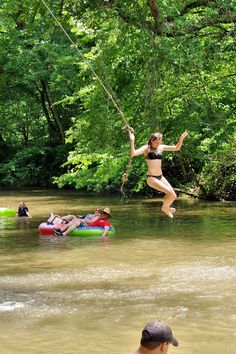

According to the American Academy of Pediatrics (AAP), children who spend time playing outside experience better physical health, are more engaged in learning, express better behavior, and are mentally healthier than kids who don't.
Making Family Mealtime Fun for Everyone
Posted on October 21, 2010
We all k

now that family dinners are important. They give children the opportunity to develop important skills like manners and communication. They encourage healthy eating habits. They help family members connect with one another. And did you know that research shows family meal time is one of the best ways to help children avoid drug abuse?
The trouble is that with our hectic family schedules, and our children’s eating preferences, regular family dinners are often rushed and/or stressful. We begin to dread the idea of dinner time and often scrap the “sit down” idea all together. And then the guilt sets in…
This article from the Goddard School website gives families great ideas for making mealtime more fun and successful.
Cut yourself (and your children) some slack– adjust your idea of what “sit-down” means when you are eating with young children. Encourage and talk about manners, but respect young children’s need to be active and to touch their food. For them eating is a complete sensory experience.
Make it fun– throw in something unexpected, like purple potatoes, broccoli standing like trees, food arranged into a picture or shape on the plate. Serve milk in little goblets. Get kids excited to see what you will bring to the table.
Get everyone involved– ask Dad to make the salad, invite the kids to wash the vegetables. Set the table together and incorporate some of the kids ideas about how to set out the napkins or which plates to use.
Explore other eating together options– when time is short, set out healthy appetizers like veggies and hummus, cheese and crackers or other quick finger foods and have a family “happy hour” together. When you know evenings will be busy, plan a family breakfast or lunch.
Family time is important, and when we take the time to be together around a meal, we are also teaching our children the importance of eating right. And while it is nice to slow down, gather everyone around the table and enjoy food and conversation together, don’t let that ideal feel like your only option. The goal is to connect with one another and teach healthy eating habits. The way you can accomplish this can be as unique as your family!
Share this:
Related
Fight Childhood Obesity: Get Preschoolers Moving!April 13, 2010In "Health"
Everybody Wins! A Fresh Take on Preschool GamesOctober 17, 2009In "Activities for Kids"
How to Talk With Parents About Preschool Learning ExpectationsMay 21, 2009In "Importance of Play"
Common Traits of Successful Families
9 Successful Family Traits
Protecting your family’s mental health and maintaining strong family relationships is a challenge even in the best of times. These days, it can feel more overwhelming than ever. As a parent and role model, building a healthy family while living through a global pandemic, helping your child navigate school, and keeping an eye on social media may feel like a daunting task. It can be difficult to know where to prioritize your time and energy to have the most significant impact on everyone’s well-being. So what traits make a family successful?
Research from the U.S. Department of Health and Human Services (HHS) that compiled findings from various disciplines (psychology, psychiatry, social work, sociology, and marriage and family counselors) provides some guidance and is supported by research from Oregon State University – Cascades.
According to the HHS research, successful families are enduring, cohesive, affectionate, and mutually appreciative. Family members communicate with each other frequently and fruitfully, and children go on to form successful families of their own. “They are not necessarily families that are trouble-free,” researchers noted. “Some have experienced health problems, financial difficulties, and other problems. But they are adaptable and able to deal with crises in a constructive manner.”
What Are the Top Traits of Successful Families?
According to the HHS research, nine traits exist in strong, healthy families:
Expressing appreciation.
Time together.
Encouragement of individuals.
Communication.
Ability to adapt.
Religious/spiritual orientation.
Social connectedness.
Commitment to family.
Clear roles.
Embark Division President Dustin Tibbitts, LMFT, characterized the traits of successful families as straightforward for parents looking to assess and improve their family dynamic. “Their straightforwardness can be helpful because often parents tend to make it too hard,” he said, adding that parents also take a lot of shame upon themselves when things aren’t going well.
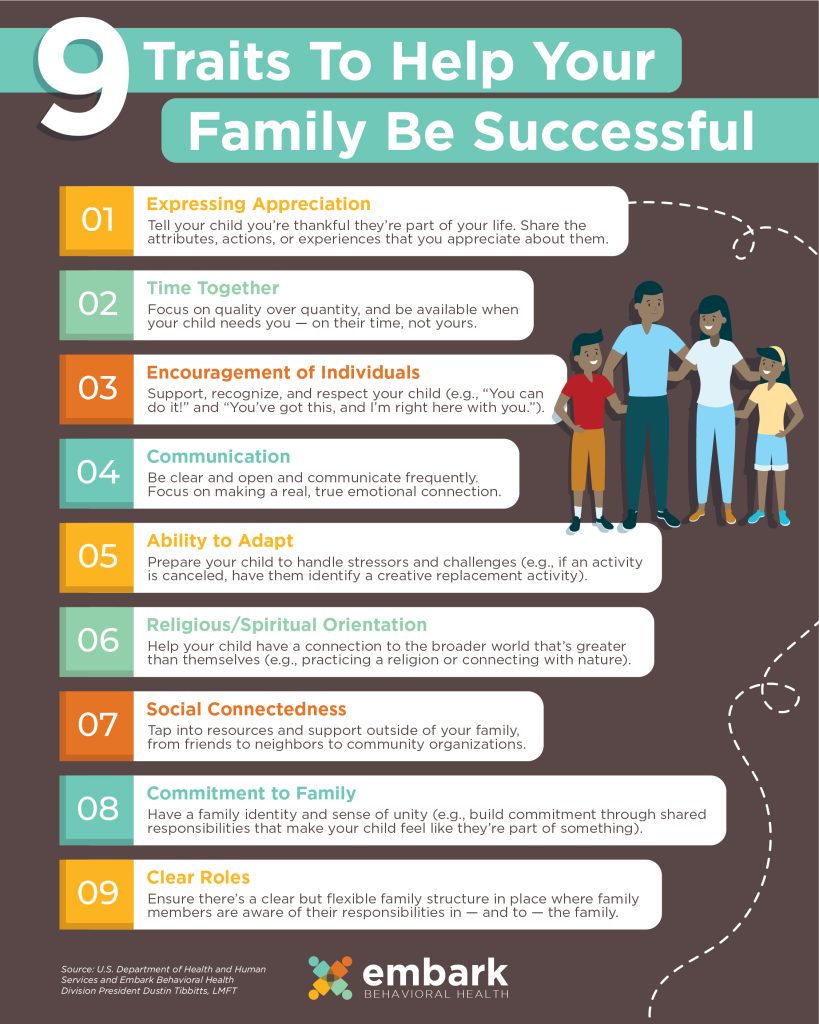
Below, Tibbitts explores the nine traits and offers tips for parents.
1. Expressing appreciation
When was the last time you said thank you or told your child you are grateful for them? Tell them you are thankful they are a part of your life and share the specific attributes, actions, or experiences that you appreciate about them. These simple gestures are compelling for successful family life.
According to Tibbitts, “The No. 1, most important way to help mental health is the expression of appreciation and gratitude. It sounds hokey, but it’s extremely powerful.”
2. Time together
When it comes to time together, there are two key concepts:
Focus on quality over quantity. For example, when you’re together, practice active listening, which involves reflection (paraphrasing what your child says) and empathy (understanding their emotions based on what they share with you).
Be available when your child needs you — on their time, not yours.
“A lot of parents feel guilty because they’re not out playing ball with their kid, taking them on trips, or going shopping,” Tibbitts said. “But really, what kids want is the time when they want it.
“So, if your teenager approaches you at 9 p.m. and you’re tired, but you give them time, that’s what they want. Even a half-hour goes a long way. Of course, it’s harder to do that when you’re exhausted, but successful families do that. They give their kids time when they need it.”
3. Encouragement of individuals
This may sound similar to the first successful family trait, but there’s an important distinction.
“Encouragement is different than appreciation,” Tibbitts said. “Appreciation is gratitude. Encouragement is saying, ‘You can do it!’, ‘There’s hope for the future!’, and ‘You’ve got this, and I’m right here with you.’”
Encouragement should take the form of mutual support, recognition, and respect. The HHS research noted that “Strong families cultivate a sense of belonging to a family unit, but also nurture the development of individual strengths and interests. Members enjoy the family framework, which provides structure but does not confine them.”
4. Communication
In the HHS research, experts recommend that families’ communication be “clear, open, and frequent.” They also noted that “Family members talk to each other often, and when they do, they are honest and open with each other.”
Tibbitts added that parents should focus on a real, true emotional connection that’s delivered in a way your child can receive it. Parents can assess if their child is receiving and internalizing connection based upon their body language, word choices, eye contact, voice tone, use of appropriate touch, conversational pacing, how often they seek parents out, and other cues.
5. Ability to adapt
Can your family react to and handle stressful situations in constructive ways? Can you grow and change when the circumstances demand it?
Tibbitts said, “Most psychosis, most neurosis, and most mental health problems come from rigidity and the inability to adapt.”
By teaching your children flexibility and adaptability, you prepare them to handle the inevitable stressors and challenges that life presents. For example, when a child fails at a school assignment, parents can work alongside them to provide support in giving it another go. If a child faces a disappointment like an activity canceled due to COVID-19, parents can encourage their child to come up with a creative replacement activity instead of doing nothing.
6. Religious/spiritual orientation
Having a connection to the broader world is vital for healthy development. According to Tibbitts, “Families that are successful share a common spirituality. This is not religion, per se, but a deep spirituality — a connection to something greater than yourself. Expressing that with your child, and helping them tap into that connection for themselves, goes a long way.”
Spirituality can be found in many places if you are not religious. Connecting with nature and your community can help put your child and family in a frame of mind to feel a part of the world around you.
7. Social connectedness
Tapping into the resources and support of groups outside your family — from friends to neighbors to community organizations — is crucial for creating strong bonds for family members.
“I’ve interviewed a lot of families,” Tibbitts said, “and families who have traditions that involve participation in the community are more successful than others.”
These community ties could be as simple as celebrating the Fourth of July with your neighbors, maintaining a tradition with your friends to share Thanksgiving together, or caring for an ailing neighbor. This stable base outside the family provides another layer of support to help cope with adversity and build meaning into life’s challenges.
8. Commitment to family
According to the HHS research, in a committed family, “They have a sense of being a team; they have a family identity and unity.” This commitment goes two ways, from the individual to the family and the family to the individual.
One way to build this commitment is through shared responsibilities.
“Especially for teenagers, they need to feel like they’re part of something,” Tibbitts said. “As much as they fight it, they’ve got to have some sense of meaning in the family, and that’s accomplished through responsibility.”
For example, many families have pets their children are responsible for. Helping aging grandparents with chores around the yard, babysitting younger siblings, changing the oil in a car, helping decorate for a holiday, and taking a turn cooking dinner are other good examples.
9. Clear roles
Knowing where you stand in your family structure and what role you play in times of crisis is critical for a well-functioning family. The HHS researchers noted, “With a clear yet flexible structure in place, family members are aware of their responsibilities in and to the family. Consequently, in the face of crises and problems, members know their roles.”
Tibbitts added, “What is your child’s role, and is it clear? What is the parent’s role, and is that clear? We see a lot of problems with families who are so fluid and nebulous that the kids are simply confused all the time.”
For example, Tibbitts said, some single parents defer the correction of siblings to an older child, and this can be confusing. “Take a moment to sit down together and outline when and where this might be appropriate so that the child knows what it means to be an adult versus an older sibling,” he said.
Similarly, some families allow children unsupervised access to credit cards, cellular phones, and the Internet. Tibbitts said taking time to thoughtfully set limits and boundaries around money, time with friends, and time online is an adult role — and it will result in children feeling much more secure and stable.
Final Thoughts
By striving to ensure your family reflects the nine traits of successful families, you can provide a healthy and nurturing environment not only for your child but also for future generations.
“Families with clear roles who spend time together, communicate well, adapt to stressors, appreciate and encourage one another, and are connected to their communities and to something greater than themselves are successful — and they’re setting future generations up for success as well,” Tibbitts said.
How to get your child to play outside
Here's How To Get Your Child Playing Outside More
If the pull of screens and the comfort of the couch have made the outdoors a tough sell to your child, start by reminding yourself that you don't have to trek to a national park. Nature is, after all, everywhere. Here's a list of oh-so-doable ways to bring a little more fresh air into your family's life.

Try your hand at rockhounding
Have a budding geologist on your hands? Or maybe just a kid who loves to dig in the dirt? Rockhounding, otherwise known as amateur geology, is a fun way families across the country have started to spend time outside.
The activity involves collecting mineral specimens, rocks, semi-precious gems, petrified wood, and invertebrate fossils from the earth. Whether you're heading out on a road trip and taking a detour or heading out on a "field trip" focused specifically on digging for rocks and gems, it's wise to check land ownership when planning a rockhounding trip.
You can check the Bureau of Land Management website and learn about rockhounding etiquette and rules and regulations on the USDA Forest Service site.
Go off-road with toy cars
If you've got a little hot rod racer at home, try this fun activity: take your remote control cars to a park to vroom-vroom over rocks, dirt, and twigs. This fantastic tactile experience is far more satisfying than driving these battery-operated cars across a carpet or a smooth wooden living room floor.
Create challenges by setting up ramps, bridges, and other wonky terrains for the cars to traverse. Not only will your child have a marvelous time with their toys, but they'll be exploring nature in an up-close and super fun way.
Playing Outside May Make Kids More 'Spiritual'
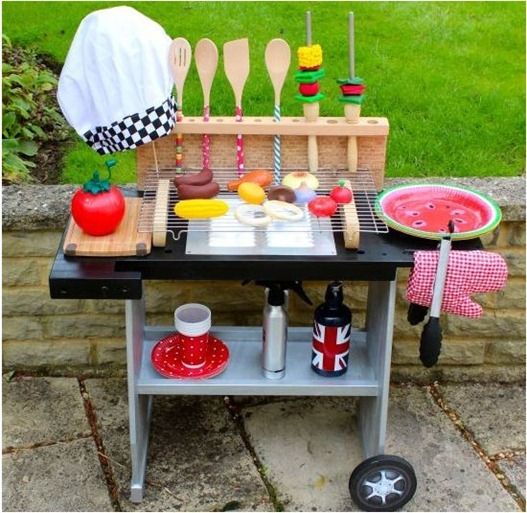
Play camp kitchen
If your kid enjoys whipping up meals of faux food, they'll love playing "campfire" in the backyard. Help your little one pack their play pots and pans, rubber chicken, and whatever else your little chef suggests into a backpack, then head out to collect kindling and build a "fire."
Is it mud season in your neck of the woods? Set up a mud pie-making station by pulling out pie plates, spoons, spatulas, and other fun kitchen stuff. Then start scooping up heaps of ooey, gooey, amazing mud, and let the creativity begin. Try decorating your pies with flowers, fun rocks, and twigs that you find outside.
13 Ways to Make Your Backyard More Fun
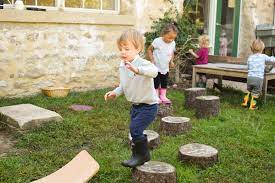
Create your own outdoor play area
Creating a special outdoor play area can make your backyard just as adventurous and thrilling as heading out to a special destination. From building sandboxes to tree houses, hammocks to tire swings to a mud kitchen den (an outdoor space equipped with bowls, utensils, a sink, water—and mud!), there are many ways to promote exploration and sensory play for your children right at home.
You could also try an obstacle course that will get kids moving or a whimsical set-up like a magical gnome garden, a bear cave, or a wild animal safari to stimulate their growing imaginations. One-off projects like rainbow bubbles can also make for a memorable experience.
7 Backyard Camping Ideas for Kids
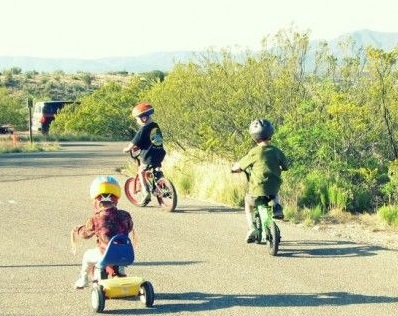
Take Barbie into the wild
Kids learn through the power of play, which is why it's so common to see kids with a Barbie teddy bear or superhero (or some other doll-type toy) in hand as they explore the world around them. Have your child pick their favorite action figure or doll that you don't mind getting dirty, and take a trip the great outside.
You can check out your local park, a forest with trails, or even your backyard, where your child can explore nature and their imagination through hands-on play. How better to demonstrate the Hulk's strength than to have him lift a real "boulder"? (Okay, it was a rock, but still.)
Independent Outdoor Play is Critical for Kids—Here's How Parents Can Help
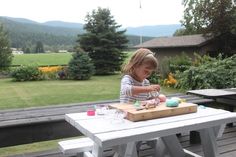
Get crafty
Little ones who like to paint on paper will be psyched to do so on snow or the driveway. Mix water with food coloring, pour it into spray bottles and let your kid channel Jackson Pollock.
If the weather is cold enough to freeze water in your neck of the woods, try adding food coloring to some water and pouring it into fun shapes like snow brick molds, latex gloves, balloons, or cookie sheets. When they freeze, you've got some wild shapes to build with. Your child can tap into their inner Michaelangelo and create fun winter sculptures.
The next time you're in the woods, gather up twigs, leaves, pine cones, and other natural fins and create a lovely glue-on-paper collage.
Go bird-watching
"Once kids are introduced to this activity, a love of nature evolves naturally," says Jane Kirkland, author of the children's book Take a Backyard Bird Walk. "Watching birds requires that kids look from the sky to the ground and everywhere in between."
Get to know the birds in your region. The next time you head outdoors with your child, bring a pair of binoculars. Survey trees, bushes, telephone poles, and grass for feathered friends. Observe a bird's colors, size, and behavior. Listen to its song, and watch how it flies.
Younger kids will need you to tell them what they're seeing, but older kids can make notes and later identify the birds in books or online. Attract birds to your yard with a bird feeder, a birdbath, or a nest box.
8 Spring Activities for Preschoolers
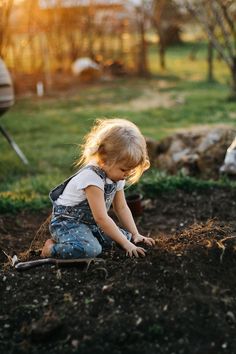
Spell it with sticks
Use a twig to inscribe letters in sand or dirt, or play the alphabet game (find elements in nature that start with a, b, c, and so on) while on a walk.

Play "rock" music
One creative and fun activity you can try at your local botanical garden or public forest is to collect items like rocks, acorns, and sticks, then seal them in storage containers. Try shaking them to hear the different sounds they make. Once you get a few different sounds, try making up a song!
24 Cheap Summertime Activities for Kids
Keep your eyes open
"One winter, my kids and I drove up to Mount Agamenticus in southern Maine and found ourselves standing face-to-face with a snowy owl, which turned and stared at us," says Veilleux. "It was magical to have such a close encounter."
Introducing kids to nature can open up a world of magical happenstance, like unexpectedly meeting a snowy owl or spotting a beautiful butterfly. Think of outings as an opportunity to learn more about the nature around you by reading up on local animals, plants, and insects.
Try documenting all of your finds by creating a family scrapbook where you and your children can jot down notes, save pictures, and even cool little trinkets—like bird feathers and sea shells—that you find along the way.
17 Things to Do at the Beach with Kids
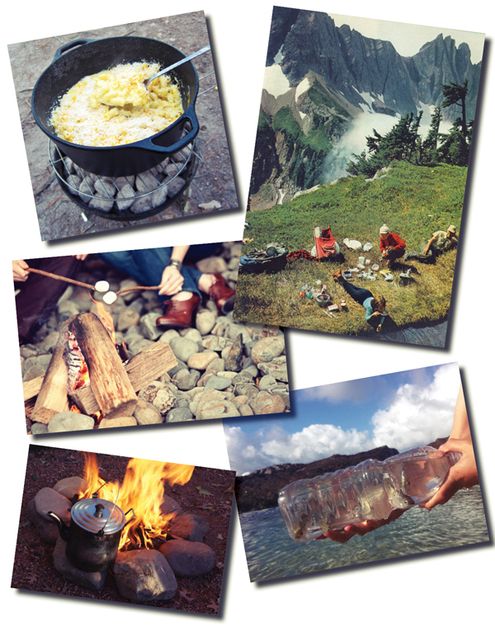
Let your kids rough it
Judy Chen, a New York City mom of Leo, 5, and aunt of Hazel, 7, does not like to camp, but when Leo begged, she and her husband took the kids on an overnight trip. It was hard but worth it, particularly as a teamwork exercise.
The family had to prepare, eat, and clean up dinner before dark, so the kids helped look for sticks to make the fire and toast marshmallows while the grown-ups prepped the food.
"The kids learned to be creative and patient and realized they don't need a lot to have fun," says Chen. "They felt proud that they were helping out, and it was a great way to bond as a family."

Lead yourself to water
Aquatic environments can reveal a whole host of creatures your child may have never seen before, not to mention textures, sounds, and scents.
"My girls love to explore tide pools," says Veilleux. "They look for sea shells and other ocean treasures, then use them to deck out their sand castles."
Little wonder the water has such a good effect—research from Michigan State University found that people who live with a view of an ocean or a lake are generally happier.
20 Fun Backyard Water Games for Kids

Plan some nature travel
You might want to plan a trip to an outdoor adventure travel destination where you can go hiking, rock climbing, rafting, or check out hot springs.
Depending on where you live, the terrain for these activities could be right in your backyard, or you might do well to check out one of the destinations touted by U.S. News & World Report's best adventure vacations, such as the Grand Canyon (which made #1 on the list), Yellowstone (which offers 3,000-plus square miles of mountains, canyons, geysers, and waterfalls), or the Adirondacks (where you can go skiing, snowshoeing, or bobsledding in the winter and biking, fishing, hiking, canoeing, and whitewater rafting in the summer).
Family Trips to National Parks
"Monitoring screen time can be difficult for parents -- especially at the moment when many children have transitioned to online learning due to COVID-19 lockdowns," Oswald said.
"Trying to encourage a balance of activities is good -- so if a child spends an hour on a video game, encourage them to get outside for an hour."
Home Buddys
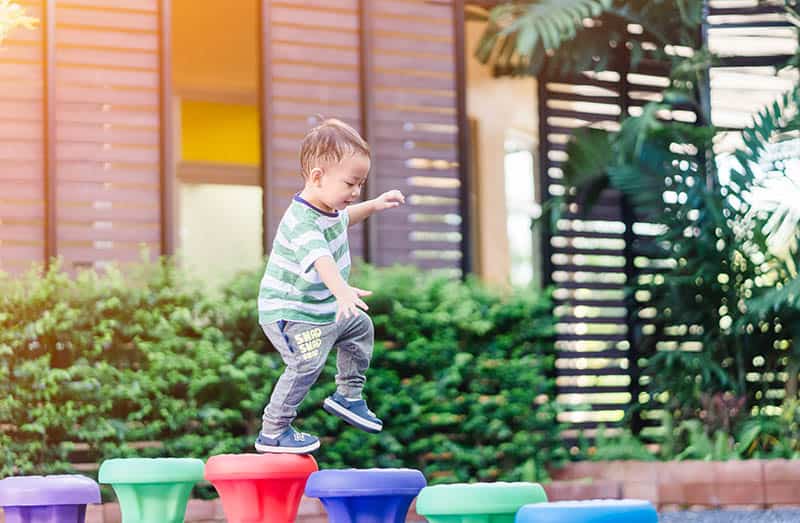
What Are Gross Motor Skills + Gross Motor Development Activities
Gross motor skills are one of the most important skills for a baby to learn as they lay a foundation for the further development of …
Read Moreabout What Are Gross Motor Skills + Gross Motor Development Activities
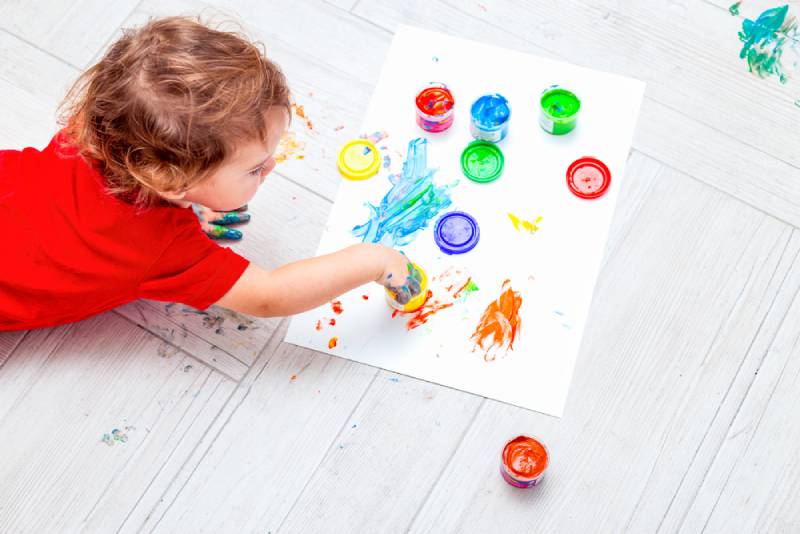
25 Best Sensory Activities For Toddlers In 2022
Sensory activities for toddlers are some of the most important activities that little ones need to engage in to properly develop the skills necessary for …
Read Moreabout 25 Best Sensory Activities For Toddlers In 2022

25 Best Rainy Day Activities For Kids Of All Ages
The weather is getting colder and the days shorter, which means you’ll need to stock up on fun rainy day activities for kids to keep …
Read Moreabout 25 Best Rainy Day Activities For Kids Of All Ages
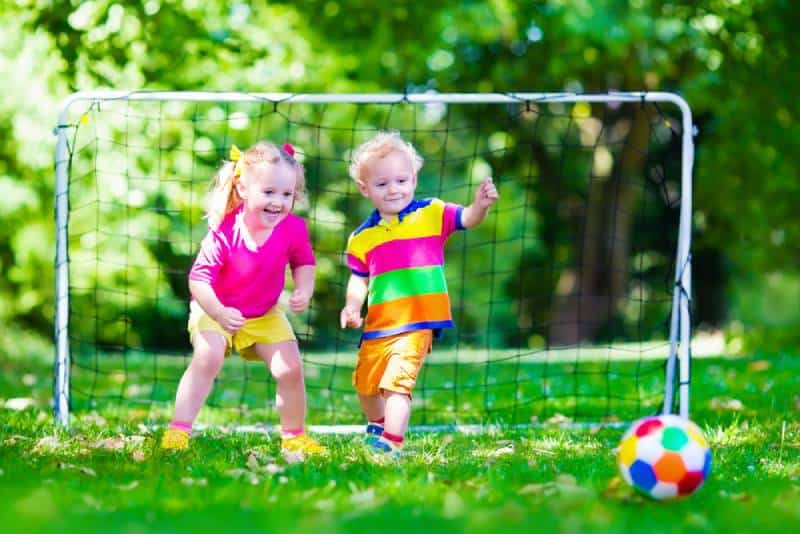
Enjoying The Sunshine: 10 Best Summer Activities For Toddlers
With the days getting longer and warmer, it’s impossible to forget that summer is almost here! For kids, this means endless days of fun in …
Read Moreabout Enjoying The Sunshine: 10 Best Summer Activities For Toddlers
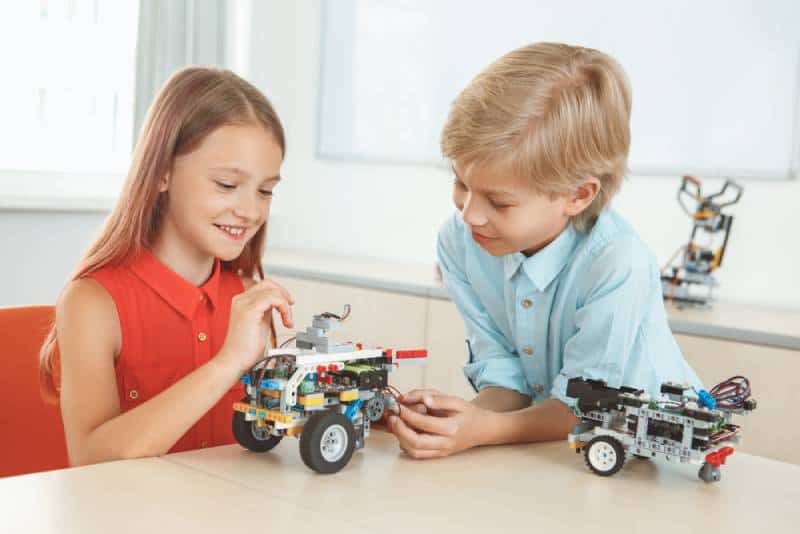
7 Best STEM Activities For Kids To Inspire Their Curiosity
If you’re looking for the best STEM activities for kids that will provide the ultimate fun, filled with plenty of motivation and curiosity, welcome aboard! …
Read Moreabout 7 Best STEM Activities For Kids To Inspire Their Curiosity

7 Best Spring Activities For Kids: Fun Ideas For Springtime Play
Spring is a season that marks new beginnings, new successes, and new life. A celebration of youth and all it stands for. This season is …
Create Your Own Natural Playground in Your Yard
Create your own natural playground; Design your Gardenscape for You!
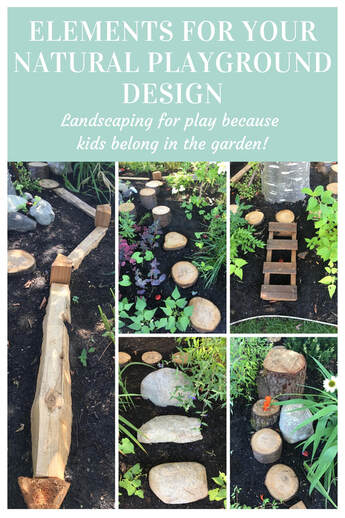
Originally posted August 2020, Updated January 2022
Let me start off by saying, “good job!” You’ve made it to August. Holy moly, 2020 has been a long year already and it’s not over yet. As I have said before, I am so thankful that I have a garden. It has provided us with so much fresh air, food, and entertainment. We have been taking social distancing seriously, so we have been spending a LOT of time at home.
You might remember from a previous post, that we had our while front yard scraped away to start fresh. That was before the pandemic turned our lives upside down. Since the first days that I stared at that blank slate, my garden design has evolved. I have strongly held the belief that gardens should have something to offer; they are not just pretty things to look at. They should provide food, places to play, wildlife habitats, feed the birds, or feed the bees. I am not one to envy a prim and proper rose garden. Concerns about food security prompted me to incorporate a vegetable patch and foodscaping elements. We added a beautiful rustic split rail fence to give our yard a park-like feel and to help contain our 2- and 4-year old kids.
This new garden gets much more midday shade, so we have found ourselves playing out front much more often. Inspired by our local park excursions, I decided to incorporated natural play elements in the garden to make it more fun, interactive, and inviting for the kids. So I set to work.
Objectives:
Create a garden for the kids to play within.
Create a space where the kids can read a book, surrounded by the garden.
Use natural elements to encourage play and exploration.
Not buy anything new.
Let me begin by saying that I am not a landscaper, landscape designer, landscape architect, or even a horticulturalist. I am a gardening enthusiast. So please excuse my rudimentary illustrations and non-technical terms.
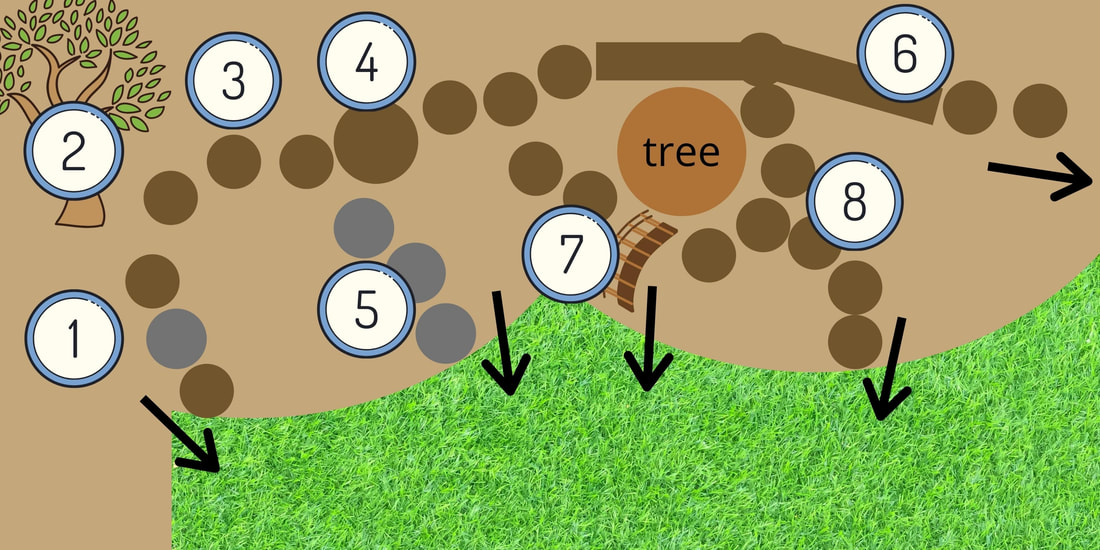
The above illustration represents the front-most portion of my garden bed. It is large; approximately 26’x10’. First of all I needed to determine the trail through the bed that the kids would use to move through the space. I used some dusty old soil to mark the path they would use. Then I let them play in the partially planted bed to see where they tried to enter and exit the garden naturally, and marked those paths as well. I also wanted a circular element which would allow them to run circuits within the bed without exiting (i.e. the trail around the large tree). I ended up with five entrance and exit points. I cleared the routes of this paths and entrance/exit points of any plantings (don’t worry, I transplanted them elsewhere).
Next step I needed to determine the elements of play on the trail. I’ll describe them sequentially by number according to the illustration above. I've also included some photos if your scroll down.
This is a rope swing jump off a stump. The stump is only about 12” high and the rope hangs from a small Japanese maple tree, marked by the tree graphic. The grey circles indicate large rocks for stepping/climbing on. The kids step up onto the rock and stump, hold onto the rope, and jump off. It’s super fun for them, and it is low enough that it is safe. This exit point is where the reading nook is found.
This area is underneath a small, but old Japanese maple tree. It is obviously a bonus if you have an established tree that you can incorporate into your natural playground. The area under our tree is clear and mulched. This is the kids’ ‘clubhouse’ where they can do free play. They have a lot of second hand figurines and animal toys which they can take out to the garden and play with here. There is also a small single rope swing with a 2x4 seat that is only a few inches off the ground for them to get on and off of easily, and it is low enough that it is safe in the event that they fall. Under this tree, they also have a section of tree stump that my Dad lovingly carved into a seat for them. This also provides a place for them to dig to their heart’s content since it is clear of plantings.
The dark brown circles in the illustration represent horizontal slices of tree trunk, cut into steppers to mark the trail. The kids can hop from one polka dot to the next, encouraging them to stay on the path rather than venture off and trample the plantings; however, I am well aware that they will probably do this as well. These slices were cut from free scrap firewood.
This is a larger stump off which the kids can jump in one direction, and down to lower/shorter stumps in the other direction. This is an old stump we saved from a tree cut down in our neighbourhood.
These are three large rocks that I repurposed from our garden bed hardscaping. They are increasing in height, like steps.
This is a balance beam created from spare lengths of wood from our split rail fence. At both end points and in the joint are short posts for stepping onto.
This is a “troll bridge” (as named by my kids) that was created from spare 2x4s, 2x2s, and broken-down pallets. It is used as an entrance/exit point.
This is a trail of stumps of increasing and decreasing heights. Again, this is made from free scrap firewood collect from felled neighbourhood trees.
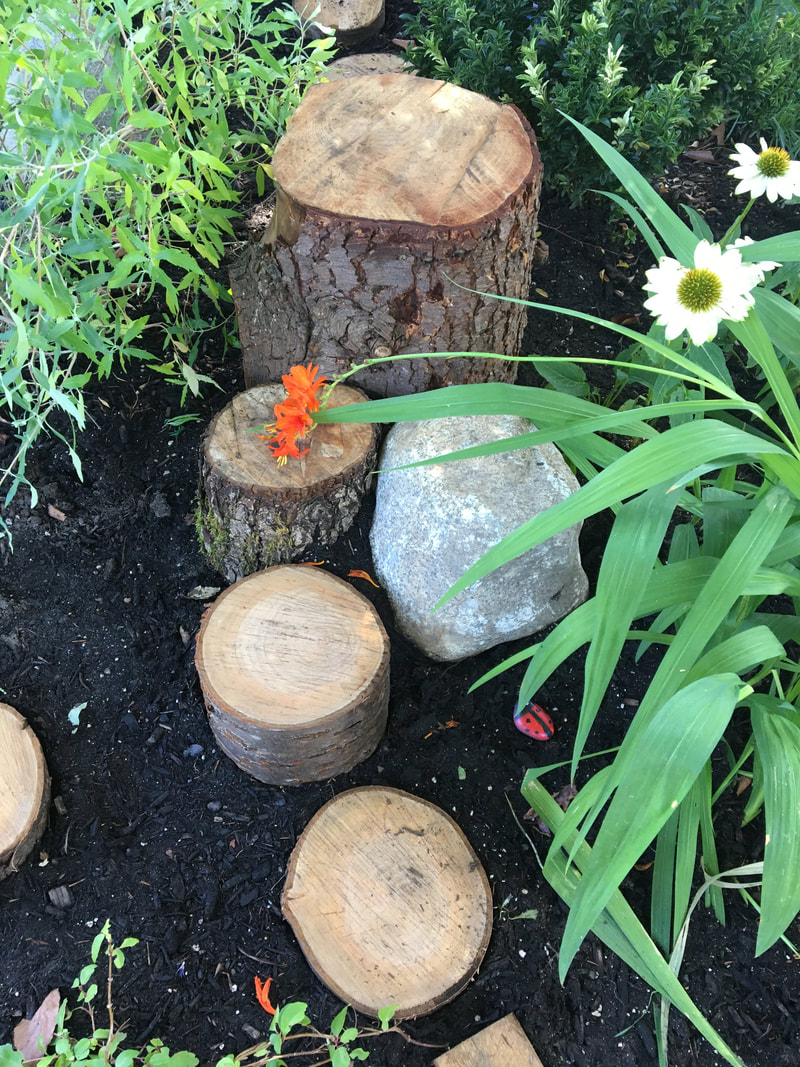
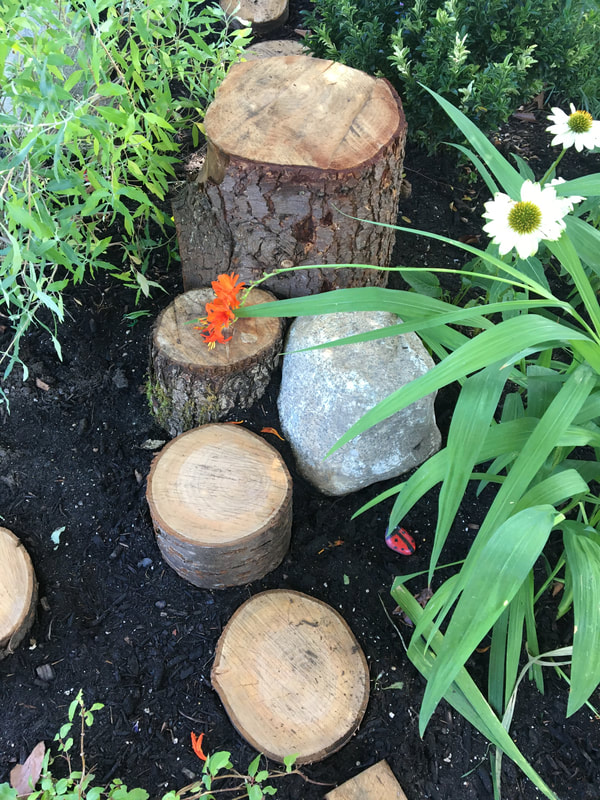
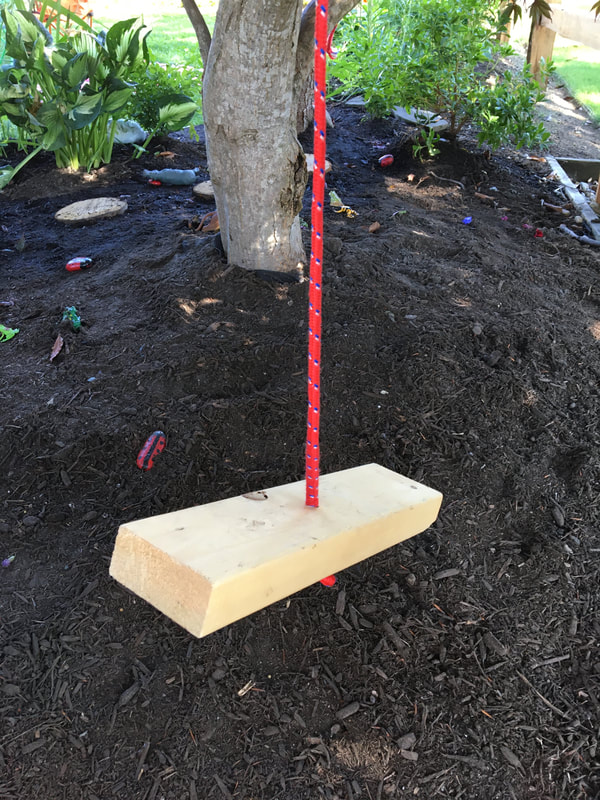
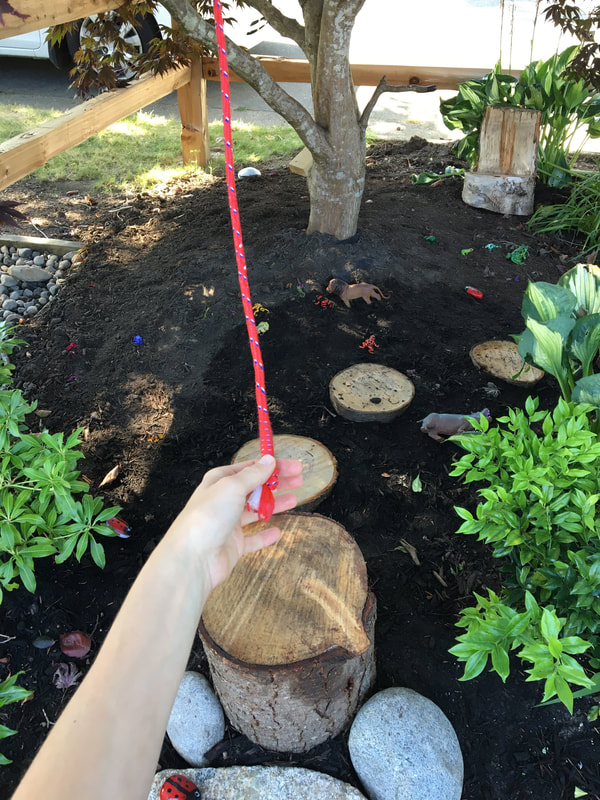
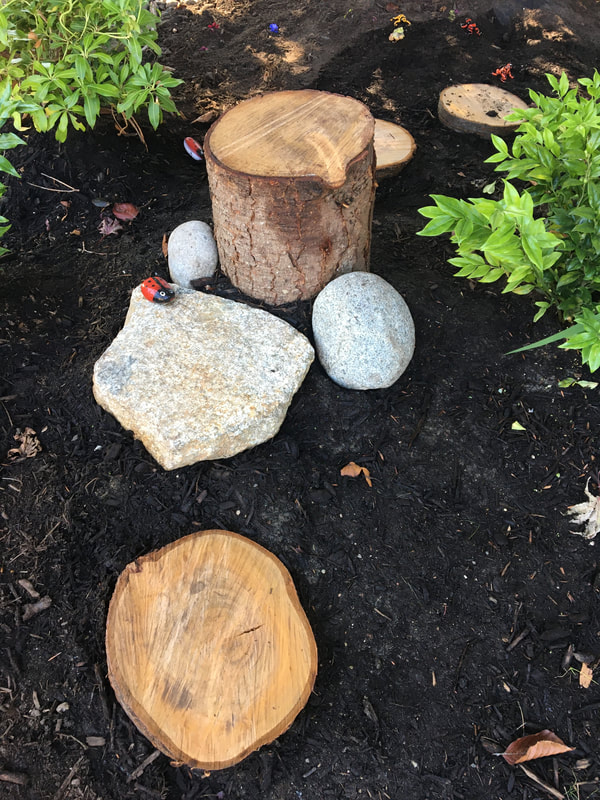
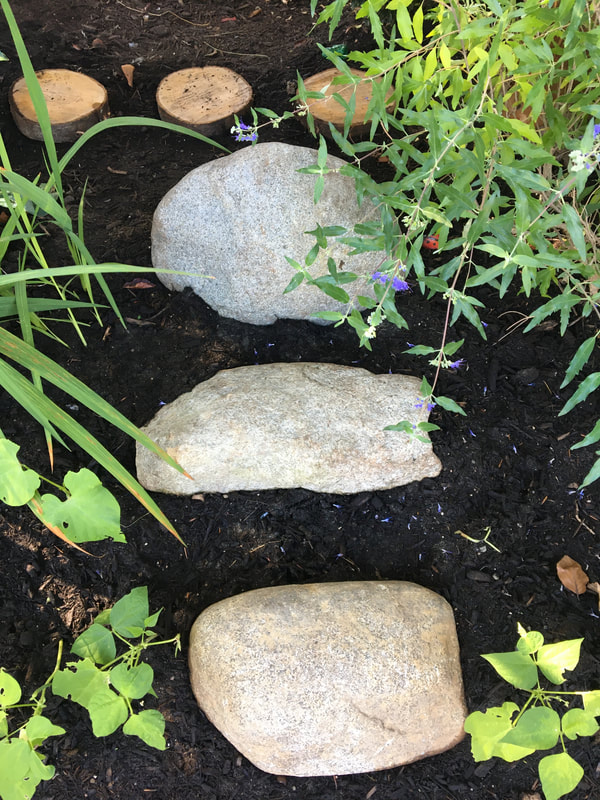
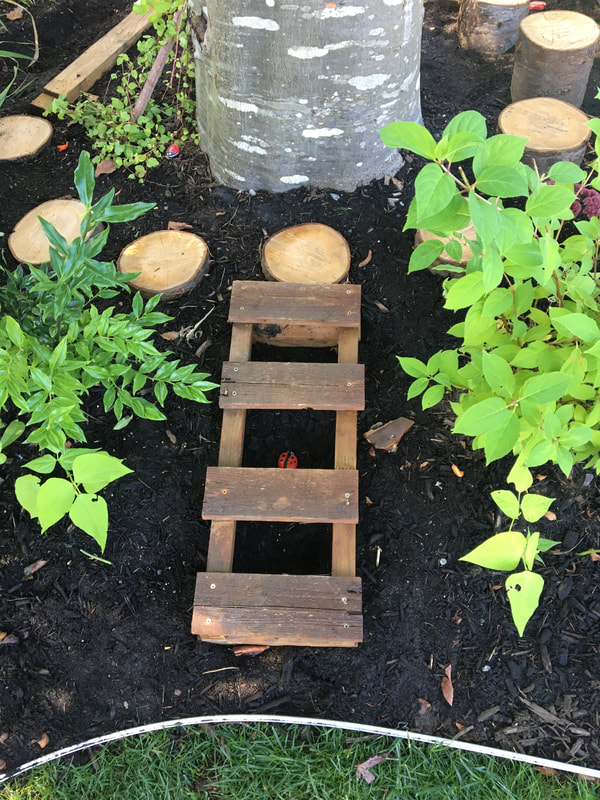
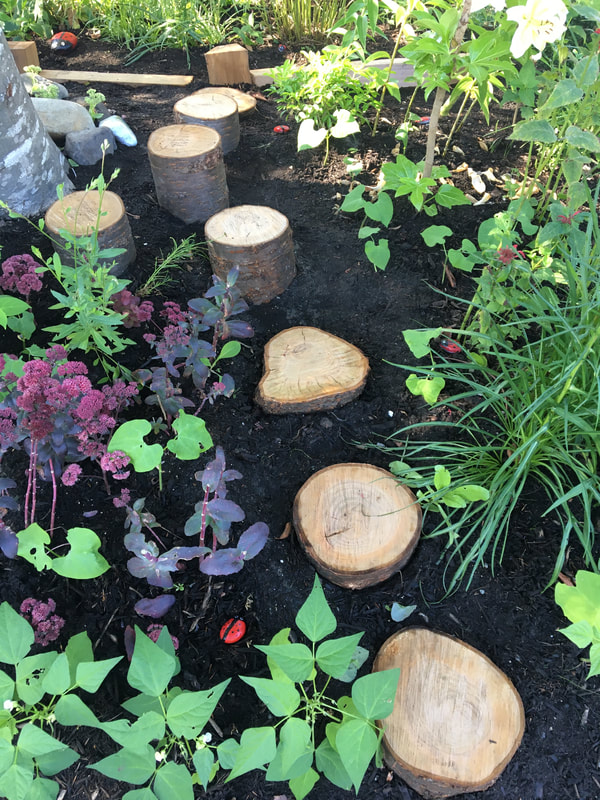
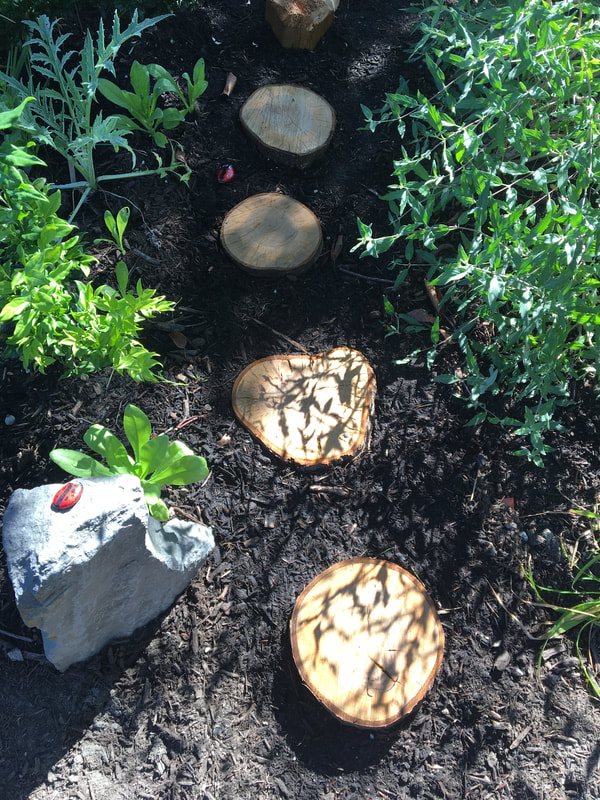
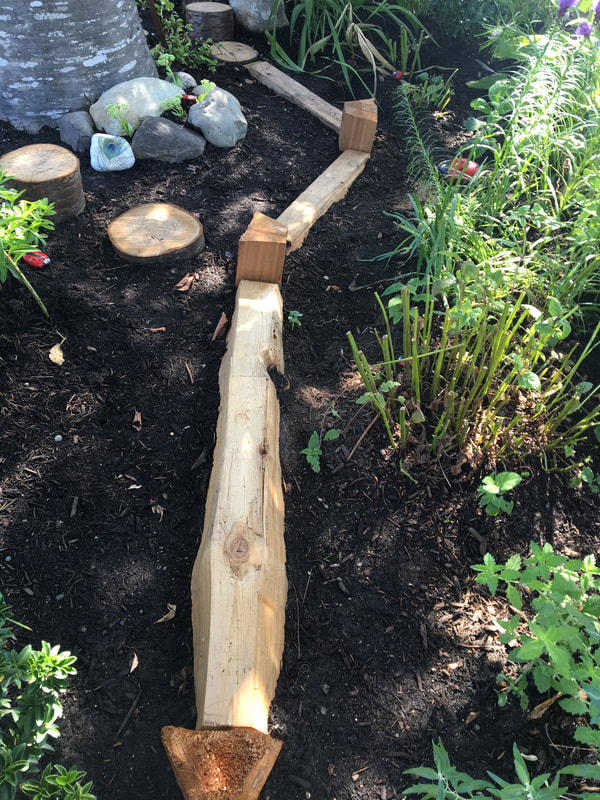
These hardscaping features were installed quickly and easily. Since this was a relatively new bed, I completed this projected over the course of a week. I am pleased that all of the features that I added were free and created from found and discarded materials. You may use the same concepts as I have but with other materials. This little garden trail has already provided the kids with HOURS of garden play. Being outdoors is important to me and I want to foster an appreciation for nature in my kids. This feels like another way to encourage this.
While you are creating your new landscape design, there are other things that you may want to take into consideration:
Encouraging birds. You can add bird feeders to attract hummingbirds or local songbirds. Plant annuals, perennials, shrubs, and trees which provide habitat for birds. Birdwatching itself can provide endless entertainment for kids and families.
Attracting beneficial insects. Add plants in the bed which will attract bees and butterflies. I have written about the importance of using your garden to feed the bees. Amidst the pandemic, we should have more empathy for bees which are facing a crisis of their own.
Create a sensory garden. Select plants for their varied textures, colours, and scents. Encourage kids to explore the difference in these plants.
Have your kids select plants and seeds! Let them choose, plant, and nurture their plant of choice so that they can feel pride and ownership of their garden space. It is also great for teaching life cycles and responsibility.
Choose kid-safe plants!!! This one is important. For example, I planted a wildflower seed mix which included foxglove which is toxic. Obviously, I ripped it out right away. Other plants like sweet peas are toxic. Make sure you do your homework.
Plant some tasty treats. My kids LOVE peas straight from the garden. I’ve planted some dwarf/bush peas for them to pick and snack on while they are in the garden. Because I have also created the surrounding garden as an edible foodscape, they also help with picking the green bush beans that I have planted around the border.
It goes without saying (but I would be remiss without mentioning) that your natural playground should be in a safe location. Ours is surrounded by a fence to contain the kiddies.
Get the kids involved with decorating your garden! There are so many arts, crafts, and activities which you can incorporate into this play area. I have been loving an almost-free craft - rock decorating! So much learning can be done outdoors in a hands-on environment. So many schools and daycares are looking for outdoor education opportunities right now because it is less conducive to transmission of coronavirus. You can achieve physical distancing and excellent air circulation outdoors. Look for my future posts on recommended activities.
And there you have it! That was a lot of ground to cover, but this is a fun project that you will find evolves as your needs and the seasons change. You may also get inspired to make additions and changes as you go. Now get outside into the garden, and dig in!

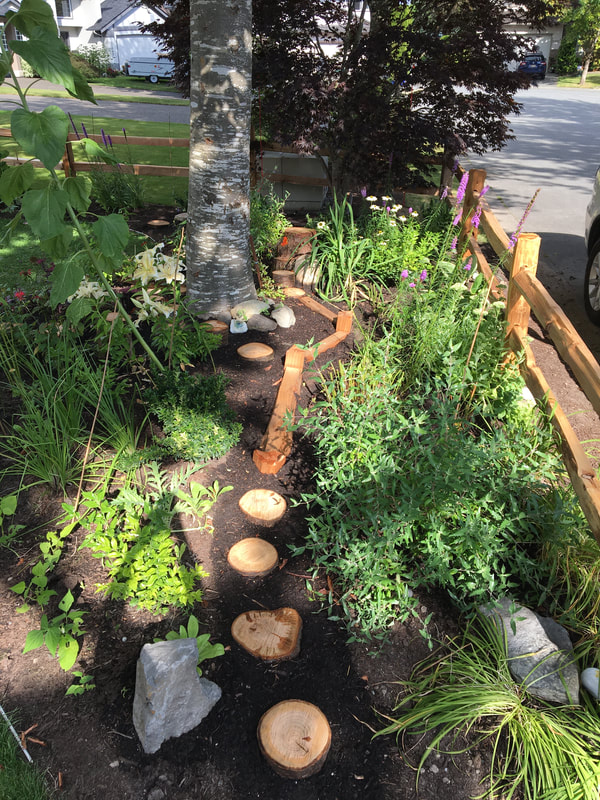
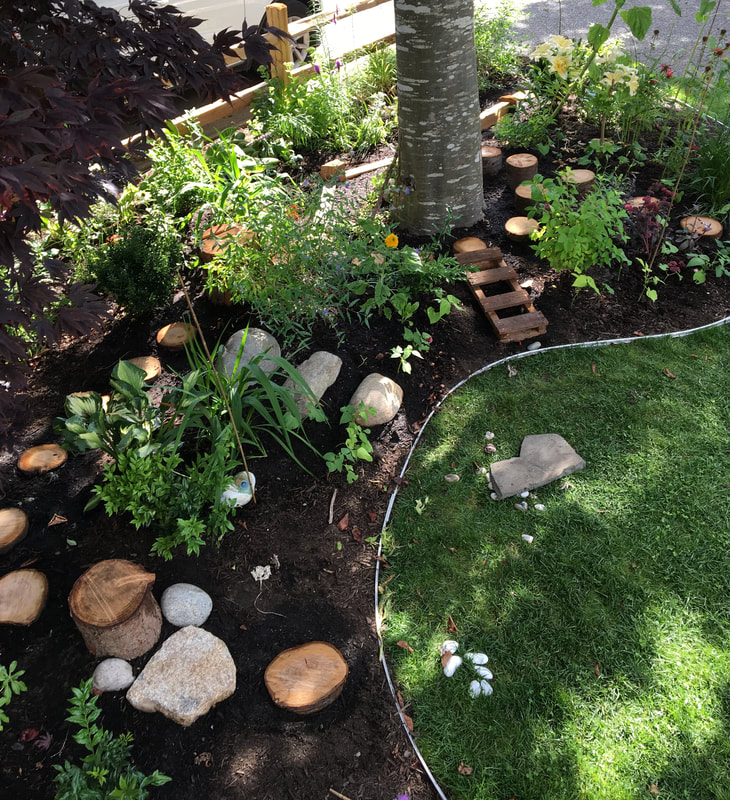
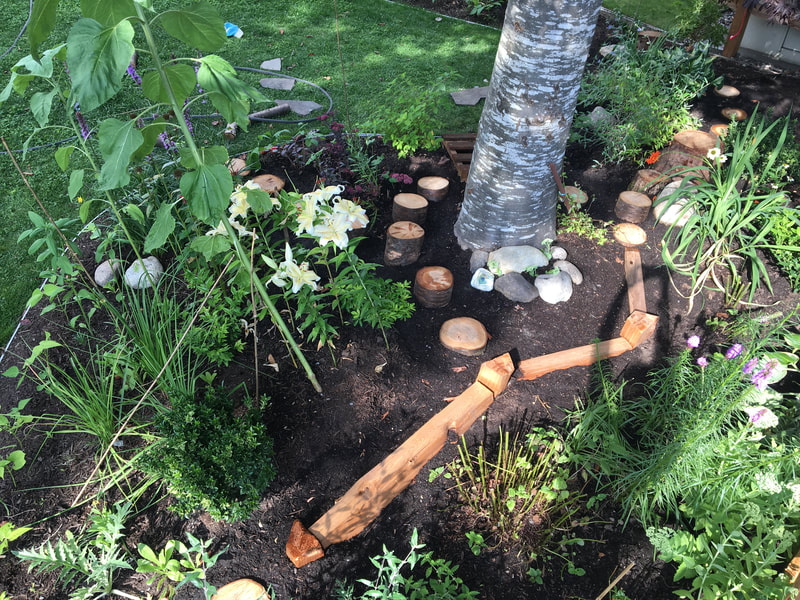
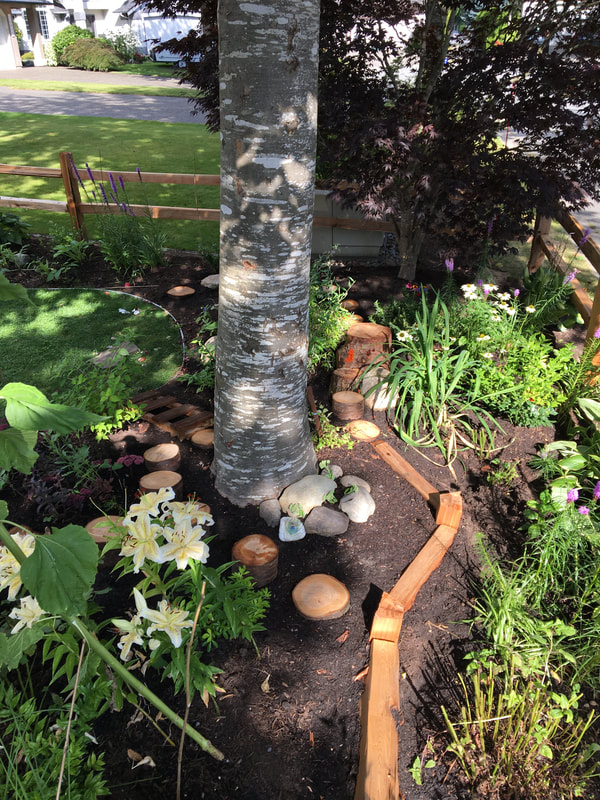
Superscript
GARDEN INSPIRATION
Welcome to my own Play Garden! I believe that gardens should be for everyone, and this space is intended to be inviting and interesting, welcoming adults, children, and furry friends alike. Children love gardens just as much as adults do and a long-lasting appreciation for flora (flowers and vegetation) and fauna (wild animals) comes from sharing your garden space with them.
(YOU ARE IN SECTION 3)
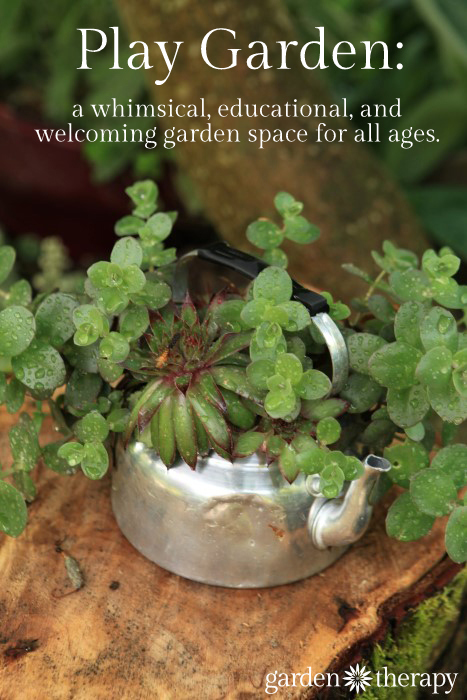
Today, I’m happy to show some photos of the backyard play space that I have been building for my family and friends to enjoy. Keep in mind that growing gardens is a long-term project and this tour begins when the garden is in its infancy. The elements have been created and the plants chosen, but it will continue to grow and develop over the season and subsequent years.

I have five gardens that I am currently working on:
the backyard play garden,
the front yard shade garden,
the perennial herb garden,
the vertical vegetable beds,
and the ornamental shade garden and quarry.
Rosemary Lemon Soap Two Ways in One Recipe
Today the tour begins with the newly created play garden space in the backyard.
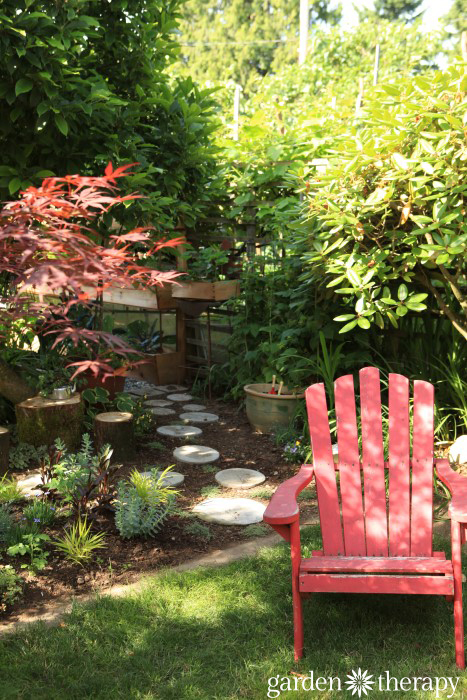
When I moved into the house, all of the structure of the garden spaces and was finished and it was just the plants that needed an update. The trees were planned out well around the property to bloom in succession, bringing interest to the garden from early spring into summer. But the garden beds were full of 5-foot tall raspberries and roses and other thorny, green things that created a visual barrier as well as an unwelcoming feeling.
The worst thing I encountered, however, was that the soil was dead. Not a worm or microbe to be found. The plants had plenty of disease and struggled to thrive in this unhealthy soil. Even worse, the home renovators buried literally tons of construction material in the soil. I worked hard over the last three years to rebuild the soil (see how to do that here) and this year, finally, I was ready to plant!
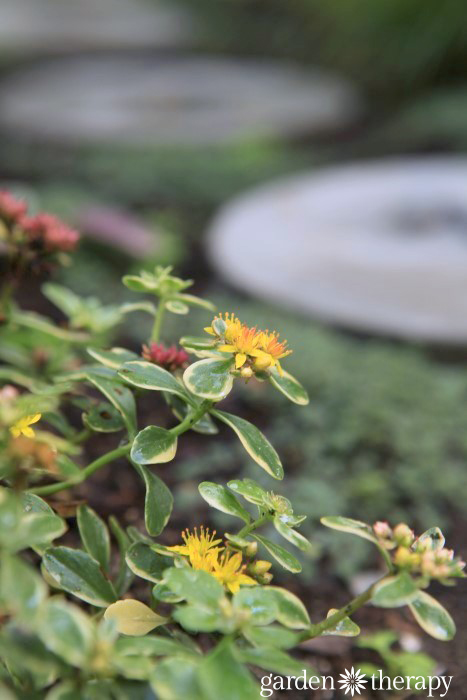
The back garden bed, just off the main lawn in the back yard is 5 feet wide and 20 feet long. A plain rectangle that had two large trees flanking either side and an awkward vegetable garden strip. My goal for the space was to retain the current structure of the center lawn with three surrounding beds but remove the tall plantings, basal prune the trees and shrubs and remove any unhealthy or crowded plants. With the heaviness of the trees and shrubs lifted there was room for new perennials, annuals and vegetables down below. The new structure created visual room around the garden, expanding the overall living space.
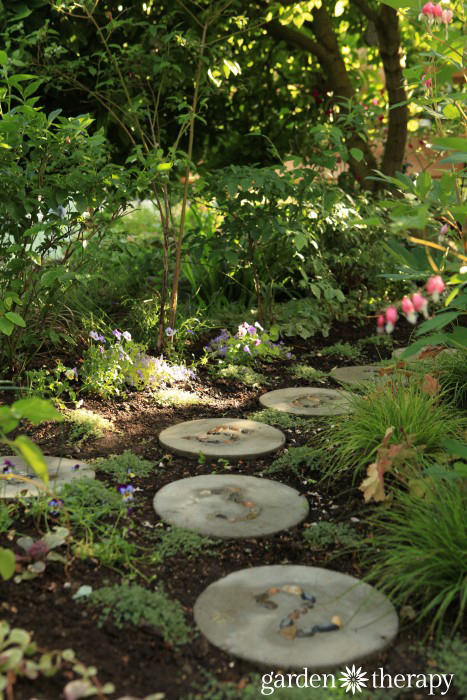
I wanted to integrate play structures for my toddler so that the yard would be usable but also beautiful and educational. Creating elements like a table and chairs made out of found wood stumps, a hopscotch pathway through the middle of the garden, and low plantings (18″ and under) that are decorative, sensory, and occasionally edible, makes for an interactive garden space that becomes an extension of the lawn.
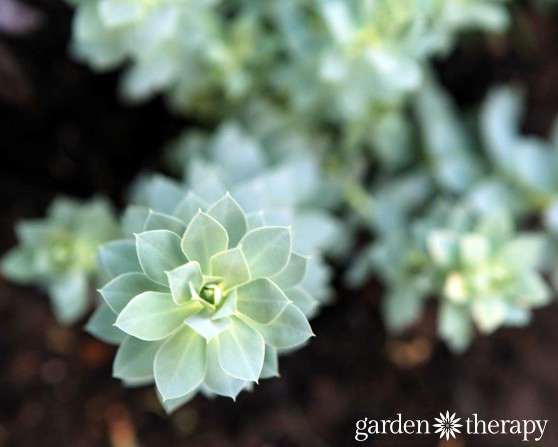
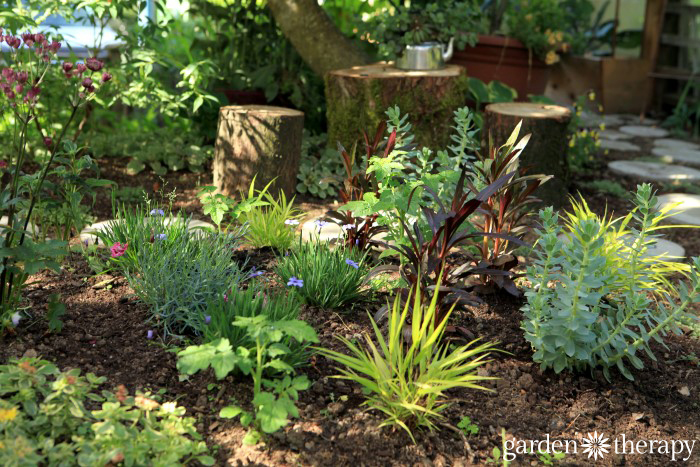
These hopscotch stepping stones were created by using this method and laid in the garden forming a path that goes by bleeding hearts, blueberries, and bunny tail grasses until it reaches the table and chairs made out of wood stumps.
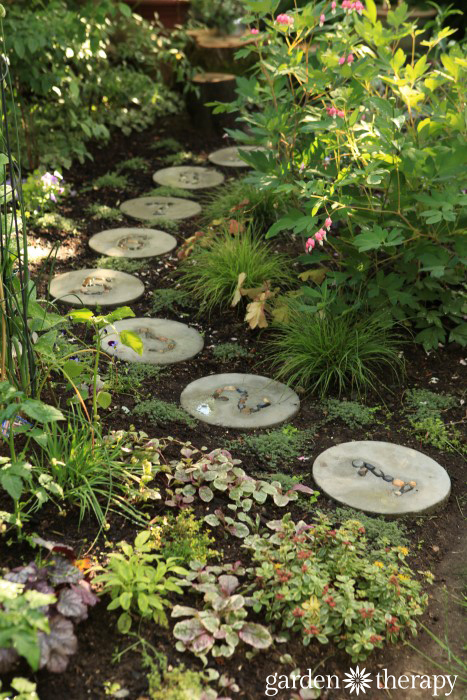

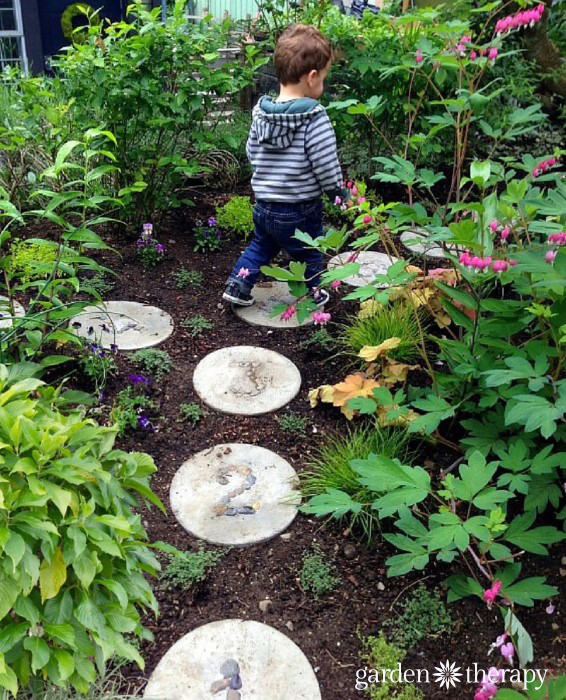
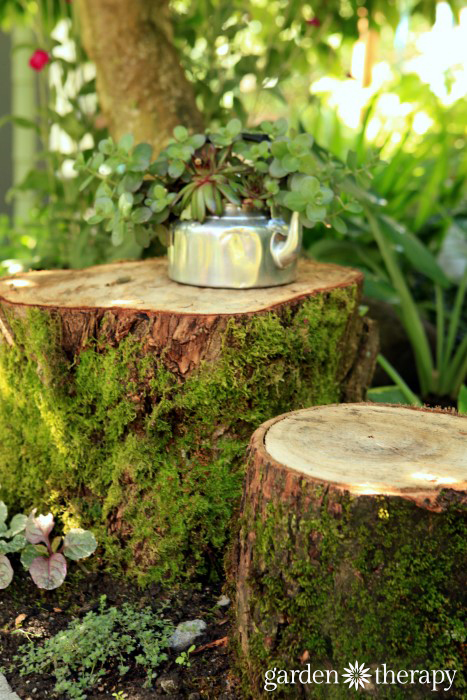
Above the table and chairs is a solar light chandelier which you can see how to make here.
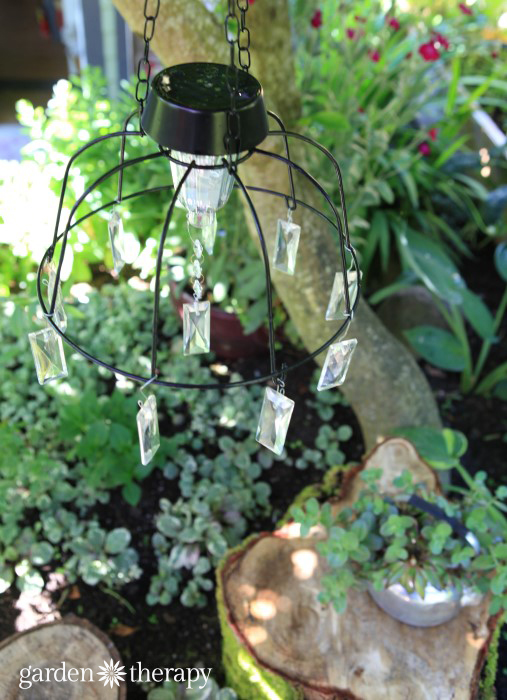
On the table, a tea kettle planted with succulents leads you to believe it is the perfect spot for a tea party.
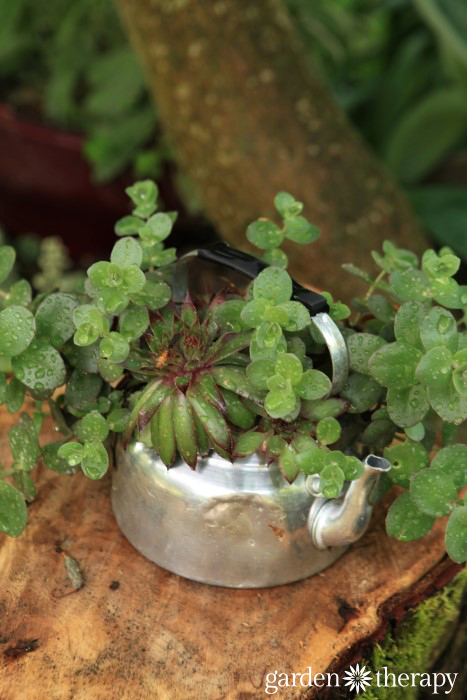
More stepping stones were created throughout the garden beyond the hopscotch stones, using prints from leaves found around the garden. See how to make these stepping stones here.
In addition, a leaf from the large rhubarb that grows at the west side of the garden was used as a mold to create the stepping stone that sits at the base of the table and chairs. See how to make stepping stones from large leaves here.
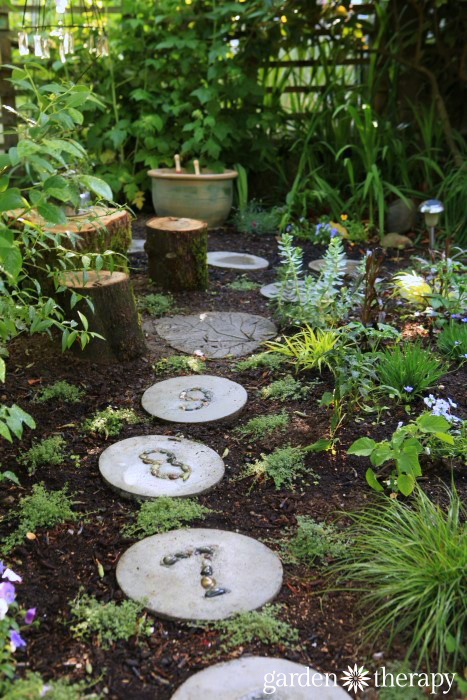
Upon exiting the play space, there is a pot for digging with a wall of golden raspberries in behind for snacking.
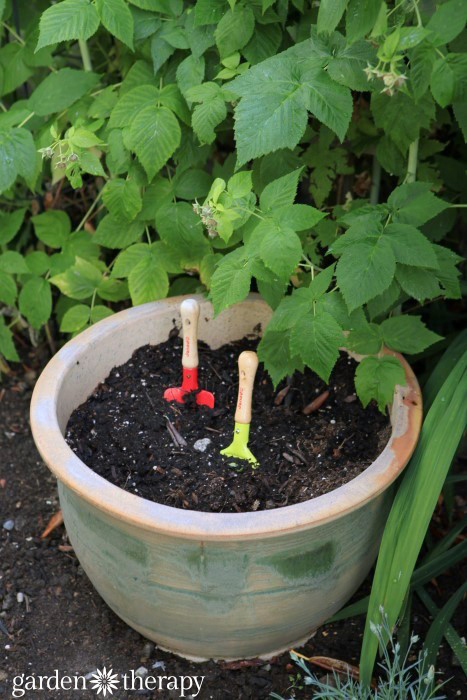
Coming out of the garden you approach two bright red Adirondack chairs, beside the Japanese maple “Bloodgood” that is planted in a large pot filled with alpine strawberry plants. I plant strawberries wherever I have a free container. More on strawberries in containers here and here and here.
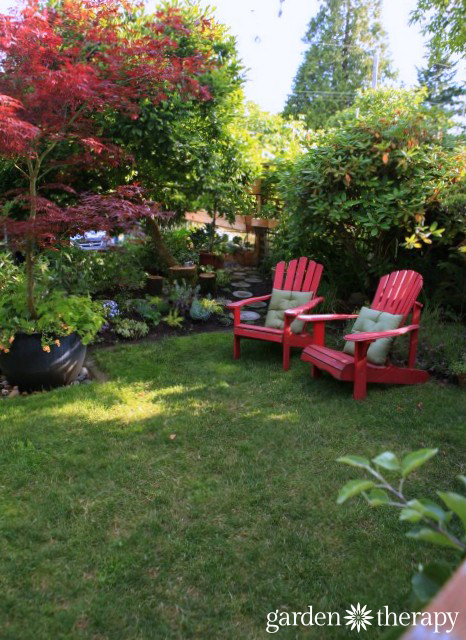

My favorite place to relax is the hammock swing. Built off the deck with an arbor structure, this hammock swing is the perfect spot to enjoy the garden. The arbor is currently growing an evergreen clematis, although it can’t be seen yet. In time it will cover the arbor providing some shade and beautiful fragrance when in bloom.
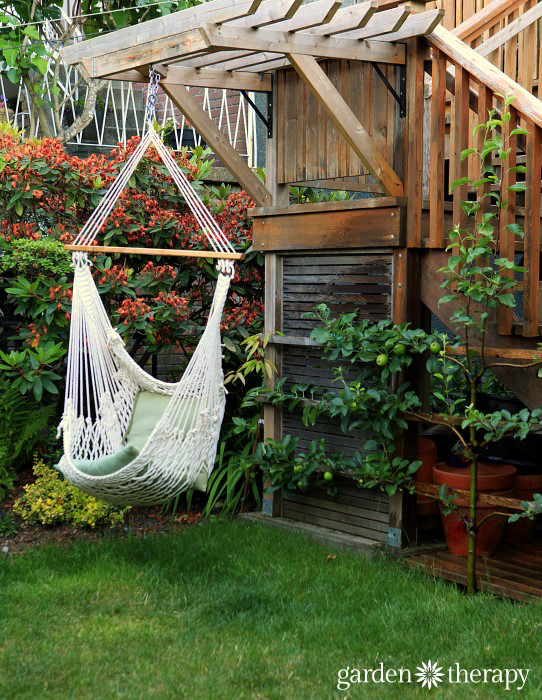
Behind the swing, growing on the side of the deck is an espaliered apple tree with five different apple varieties grafted on. The espalier tree is only two years old, yet it is producing a few apples this year! In future years, I will continue to prune and train it to produce an abundance of apples in a small space. The branches will thicken and create more buds for more apples as the years go by, but the overall height, width, and shape will remain the same.
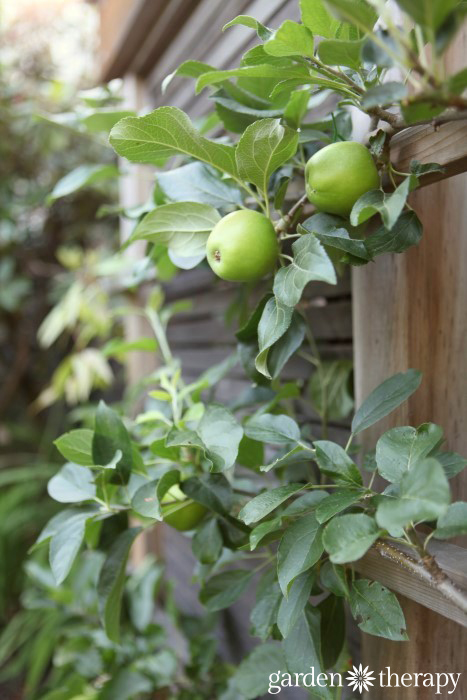
The stairs go up to the deck which overlooks the garden. Beside the deck you’ll find the perennial herb garden which makes for easy access for zipping down from the kitchen to get some fresh herbs. The herb garden contains rosemary, sage, thyme, mint, nodding onion, chives, a large fig tree, and even a small yuzu tree I was given as a gift. (See the perennial herb garden from my last house here). There are also a few hanging baskets with Tiny Tim Tomatoes and annuals sent to me from Proven Winners as part of their 2016 collection.
